- Tel +31-6-19667523 | [email protected]

- Camera museum
- Rental (NL)
- Digitize (NL)
- Search for:
No products in the cart.
Return to shop

Uncategorized
How to determine the age of an olympus trip35.
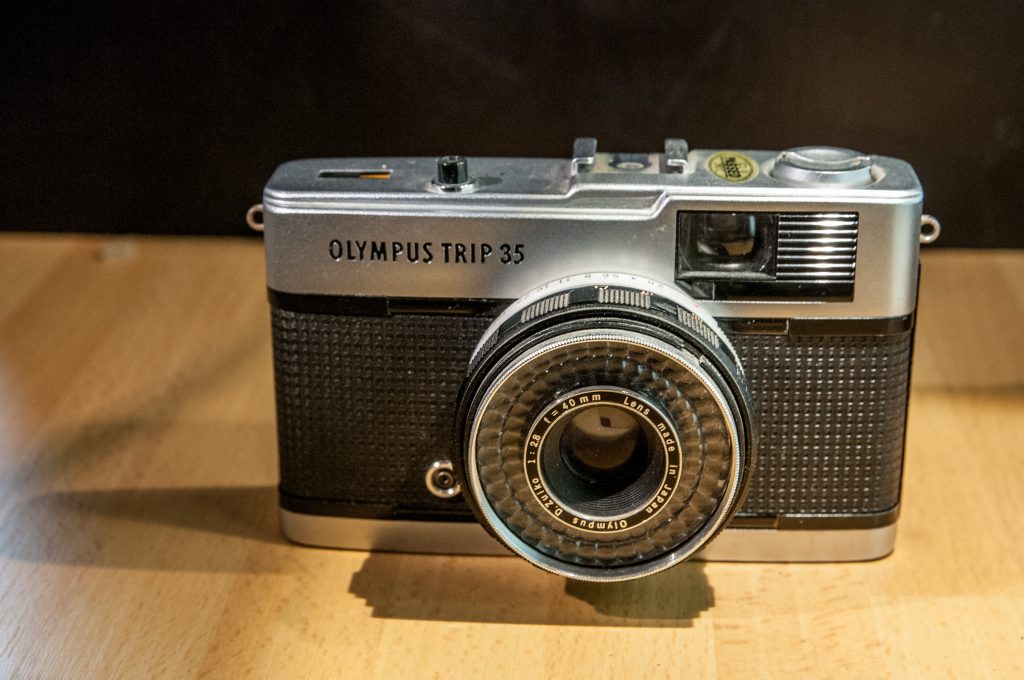
The serial number on an Olympus Trip 35 camera does *not* give you a precise date of manufacture. The only way to tell is to open the film compartment and carefully remove the pressure plate on the back of the door (this is quite easy. It simply slides free from its locating pins) and look for a code on the back of the pressure plate. The code consists of 3 characters: 1st Japanese character or letter (in later models) signifying the assembly plant.
2nd number representing the last digit of the year of assembly (e.g. 5 = 1975, 0 = 1980). 3rd number or letter representing the month of assembly, 1-9 for Jan-Sep, X, Y, Z for Oct-Dec. for example; N1Y = November 1971 Of course the TRIP 35 was manufactured between 1967 and 1984, so if you are unsure if you have a 1968 or 1978 model, the chrome shutter button is the earlier and the black the later.
Username or email address *
Password *
Remember me Log in
Lost your password?
Olympus Trip 35
The Olympus Trip 35 is a fully-automatic 35mm compact camera , manufactured by Olympus from 1967 [1] to 1984, during which time over ten million units were sold, [1] though this oft-quoted figure is likely to have included later plastic-bodied Olympus cameras with Trip branding, as the original Trip 35 had serial numbers going up to around 5,400,000. [2] The auto-exposure mechanism is effectively solar-powered by a selenium cell surrounding the lens, and consequently the camera runs without batteries. Until June 1978, the shutter button was silver-coloured metal. After that date, all Trips had a black plastic button.
- 1 Auto-exposure mechanism
- 3 Viewfinder
Auto-exposure mechanism
With the aperture ring set to "A", the camera operates as a program automatic with a working EV range of 8.32-17.4 at ASA 100. [3] Half-pressing the shutter-release button locks the exposure with both the aperture and shutter speed (of which there are only two, 1/40 and 1/200s) fixed by a delicate but accurate mechanism. As explained by one repair page ,
The combination of aperture and shutter speed that the exposure mechanism chooses depends on the amount of light available. The precise amount of light that triggers a change of the shutter speed is not documented in the user manual, but it is believed to be around EV 13. When brightness of EV 13 or more is detected, the Trip 35 will increase the shutter speed to 1/200 sec in preference to using a smaller aperture, and use a narrower aperture as light levels increase from there, presumably to avoid the diffraction effects that affect all 35mm cameras below f/11. [4] Below EV 13, it will use the 1/40 sec speed and widen the aperture for lower light levels. The camera will refuse to fire if there is not enough light, with a red plastic flag appearing simultaneously in the viewfinder. This mechanism makes it impossible to make the error of shooting with the lens cap in place.
When the aperture is set manually (primarily for flash photography), the shutter speed is set to 1/40th of a second. However, the meter is still active even in this "manual" mode. Setting the aperture manually merely sets the widest permissible aperture, and the auto-exposure mechanism may still choose to set a smaller aperture than this if it sees fit. [4]
Other than this, the camera offers no controls for setting exposure manually, though one can easily set exposure compensation by changing the film ASA dial to a higher or lower value.
The Trip 35 has a 40mm f/2.8 Zuiko non-interchangeable lens, with four elements in three groups. Ken Rockwell suspects this to be a front-element focusing Tessar . [5] This lens has a reputation for being extremely sharp, even in the corners; in Rockwell's tests, Costco-scanned Fuji ISO 400 print film loaded into this camera out-performed a Canon 17-40 f/4 L lens in the corners. [5]
The lens provides simple zone-focusing with 4 cute distance symbols marked on the top-left of the lens. These correspond to the real distance markings on the underside of the lens: 1 meter, 1.5 meters, 3 meters, and infinity. Filter ring is 43.5mm.
The viewfinder is an albada-type, with parallax markings for closer focusing. There is a second, very small window under this, nicknamed the "Judas window", which shows the current aperture setting and distance symbol which are on the lens barrel.
A small red flag will appear in the viewfinder if the auto-exposure mechanism decides there is not enough light and refuses to fire.
This camera's aperture blades (there are two blades) tend to be become sticky over time. Before purchasing an old Olympus Trip 35, ask the seller if the aperture is properly opening and closing at all values (f/2.8-f/22). This can be done by manually selecting each aperture value and half-pressing the shutter button. Otherwise, the lens unit would have to be disassembled and cleaned.
- ↑ 1.0 1.1 Olympus' history of EE-equipped cameras (archived)
- ↑ Serial numbers collected by the Olympus Trip Flickr group
- ↑ Specifications in the user-manual.
- ↑ 4.0 4.1 See the Trip 35 program graph , and the explanation in this thread .
- ↑ 5.0 5.1 http://www.kenrockwell.com/olympus/trip-35.htm
- Manual available from UCL
- Olympus Trip 35 group on Flickr
- A modification that allows a 1/200 shutter speed with manual aperture control
- Illustrated instructions for repairing a Trip 35
- Trip 35 in the Olympus Global History (archived)
- This is a trip at Classic Cameras by RaúlM.
- Lionel's Olympus Trip 35 page in French at 35mm-compact.com
- Olympus Trip 35 on www.collection-appareils.fr by Sylvain Halgand (in French)
- Flickr image
- Image by rick soloway
- Japanese 35mm viewfinder
- Image by Michele M. F.
- Image by Hans Jan Dürr
- Image by vincentnip
- Image by Ênio Resende
Navigation menu
Personal tools.
- View source
- View history
- List of Companies
- Community portal
- Recent changes
- Random page
- What links here
- Related changes
- Special pages
- Printable version
- Permanent link
- Page information
- This page was last edited on 7 November 2021, at 07:11.
- Text is available under GNU Free Documentation License 1.3 ; other licenses apply to photos.
- Privacy policy
- About Camera-wiki.org
- Disclaimers

- Forum Listing
- Marketplace
- Advanced Search
- Watch Discussion Forum
- Honour's Topics
Tripping the Light Fantastic: The Original Olympus Trip
- Add to quote

No, David Bailey thinks he's me.
You probably won't like this - I don't as it's a bit of a hatchet job but if someone offered a quality conversion or a modern re-run might it attract customers?
A great post and an enjoyable read. I owned three of the original Olympus Trip cameras over the years and found them all to be excellent. I even found an original Olympus Trip User Manual in a charity shop and later obtained a couple of the original soft zip up camera cases.also from various charity shops. I bought a flash attachment from a guy on Ebay who assured me it was an Olympus Trip flash unit complete with its plastic cover. Not sure if it was a genuine Olympus item but it worked fine so I was happy. Oddly enough I also obtained my Olympus Trip as a replacement for a Zenith SLR although mine was the equally troublesome and more basic Zenith E model. Your post has brought back some very happy memories for which I thank you. Kindest regards, Chris (Service Engineer)
- ?
- 55K members
Top Contributors this Month

Olympus Trip 35 (1967)
This is an Olympus Trip 35, a 35mm scale focus camera made by Olympus Optical Co., Ltd. between the years 1967 and 1984. The Trip was an extremely popular compact camera and is credited as one of the first truly successful point and shoot cameras, ushering in a new age of simple cameras to those who otherwise would never have bought a rangefinder or SLR camera. The Trip requires no batteries and uses a selenium cell exposure meter for programmed auto exposure, but also allows for the option of manually selected f/stops. The Trip came with an accurate metering system, a reliable shutter, and a quality lens which meant that it was both dependable and delivered excellent results for the millions of people using them. Many can still be found in good working condition today, making them an ideal point and shoot for film shooters looking for an easy to use, but high quality, vintage shooting experience.
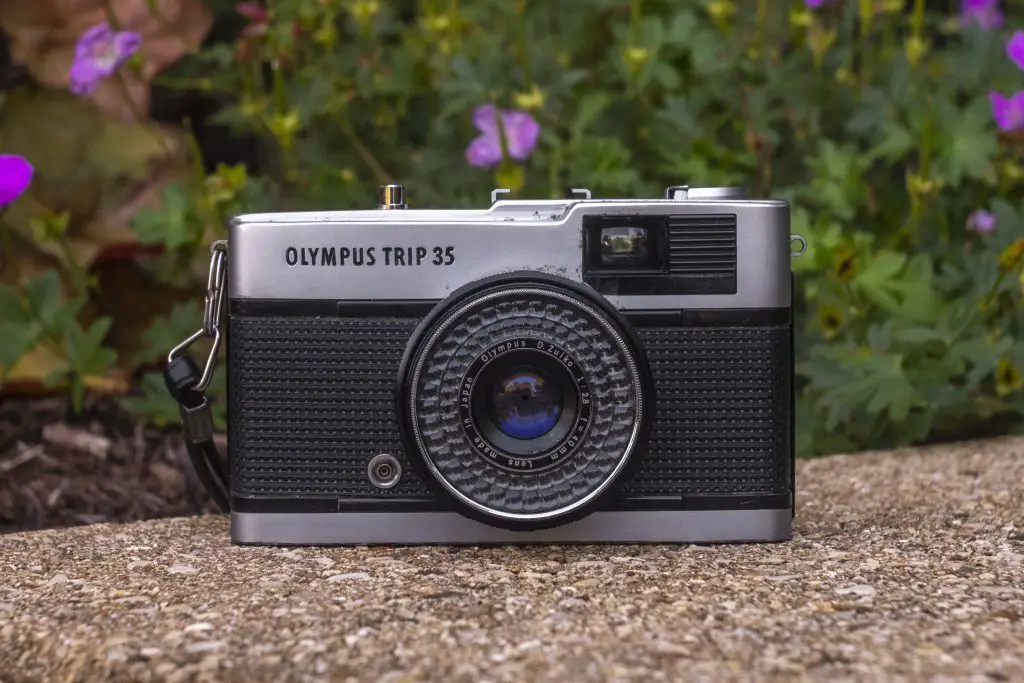
When you look at the progression of 20th century camera development, you can see some themes surrounding the style and features of cameras that were released in a particular period. Folding and box cameras dominated the earliest parts of the 20th century, Leica and other 35mm “miniature” cameras were all the rage in the 30s and 40s. By the 50s, the Single Lens Reflex began to be the preferred style of camera over the rangefinder, and at the start of the 60s, “electric eye” cameras opened up doors with auto exposure to people who otherwise wouldn’t have been able to (or didn’t want to) shoot high quality and properly exposed images.
It seems that by the end of the 1960s and going into the 70s, the industry was getting the idea that people wanted more compact and easy to use cameras, but without too many sacrifices in quality. Auto Exposure not only eliminated a lot of the guesswork that would have stumped novice photographers, but also meant that the manual controls that are needed to set things like shutter speed and f/stops could be eliminated from the design, making them simpler to produce and cheaper to sell. The prevalence of electronics, both in shutters, metering systems, and viewfinder displays also helped decrease the size of cameras compared to fully mechanical ones a decade earlier.
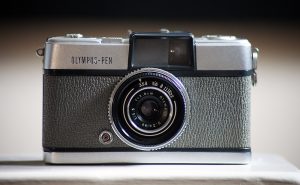
Of all the major players at the time, Olympus seemed to be the one company who did the most to differentiate themselves in the compact camera market. The half frame Olympus Pen model made it’s debut in 1959 before anyone else was making a serious effort in the compact camera segment. Each of Olympus’s subsequent full frame cameras were smaller than those released by their competitors, and although it wasn’t out yet, the upcoming OM-series SLR would offer a fully featured semi-professional level camera system in the smallest package possible.
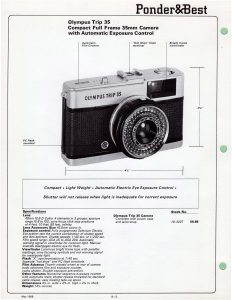
In 1968, a new model called the Olympus Trip 35 would make it’s debut to relatively little fanfare. This new camera broke very little new ground, it didn’t have the credentials of the Pen’s designer Yoshihisa Maitani , and none of it’s specifications would have excited semi or professional photographers. The name “Trip” was chosen to suggest the camera’s intended purpose as a vacation camera for people who wanted a capable, yet compact and simple camera.
Originally retailing in 1968 for $59.95, when adjusted for inflation this compares to about $450 today which is right in the realm of what a capable, yet not out of reach camera would sell for today. The Trip had a quality 4-element D.Zuiko lens, fully automatic programmed auto exposure via a selenium meter, and an easy to use focusing system with click stops for Portrait, Group, and Scenery. The camera was only slightly larger than the very popular Pen series yet exposed full sized 24mm x 36mm shots on regular 35mm film.
Throughout it’s decade and a half of production, the camera only saw very minor changes. The two most obvious were the switch from a chrome to a black plastic shutter release button and an expansion of the ASA film speeds from 200 to 400.
In my research for this article, I found very little information about the Trip around the time of it’s release and into the early 1970s. The most prevalent form of advertising was a series of commercials that aired in the UK featuring famous photographer David Bailey and his Trip.
Check out the following commercial featuring Bailey and Monty Python alum, Eric Idle .
It doesn’t seem as though the camera caught on until a few years after it’s release, but once it did, it remained a very popular model being sold until the early to mid 1980s. Many sites on the Internet today suggest that up to 10 million Trip 35s were sold , but based on serial number research, the actual number is probably closer to half that. But even with 5 million units sold, the Olympus Trip 35 remains one of the most successful single models of any camera ever made.
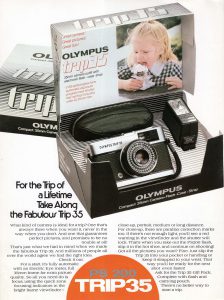
By the time the Trip 35 went out of production in 1984, there were already a huge number of more advanced cameras with more features, yet the appeal of a mechanical camera that worked without a battery and could still deliver quality results is why it stayed around for so long.
Olympus recognized the success of the Trip name and would reuse it in a series of simple auto focus cameras that were in production from 1984 to 2000, but none with the long lived popularity as the original Trip 35.
Today, the Olympus Trip 35 remains a very popular model for collectors and film enthusiasts alike. A combination of a plentiful supply of them that can be found cheaply, good reliability, and an easy to use design that produces excellent results means that almost everyone who uses one, still has favorable things to say about them. This is a model that is highly recommended by many, including me, and one that definitely deserves a place in your collection.
Year of Production
The Olympus Trip 35 was in production for about a decade and a half, and a common question among collectors is when was my camera made? There are a few articles online suggesting that the earliest models have 6 digit serial numbers and the first 7 digit serial numbers appeared in 1971 – 72, but the Olympus Trip 35 Flickr group has a post that suggests the month and year of manufacture can be revealed by a date code stamped on the underside of the film pressure plate.
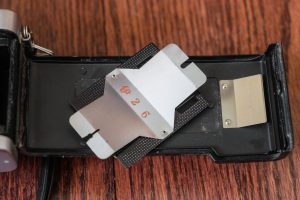
The pressure plate is easy to remove as it simply needs to be pulled off on one side. Do it slowly so as not to bend the clips, but I was able to get mine off without any damage to it. Sure enough, on the back of mine, I saw the number 26 which suggests mine was made in June 1972. I’ve copied the relevant information from that Flickr group here, and take no credit for this information.
- 1st Japanese character or letter (in later models) signifying the assembly plant.
- 2nd number representing the last digit of the year of assembly (e.g. 5 = 1975, 0 = 1980).
- 3rd number or letter representing the month of assembly, 1-9 for Jan-Sep, X, Y, Z for Oct-Dec.
The Trip 35 was manufactured between 1967 and 1984, so if you are unsure if you have a 1968 or 1978 model, the chrome shutter button is the earlier and the black the later.
Further reading through the discussion in this thread, it appears that later Trips either don’t have this number stamped anywhere, or the numbers that are there don’t make any sense so it’s possible that the later cameras either used a different system, or none at all, but this should at least allow a good number of Trips to be dated.
My Thoughts
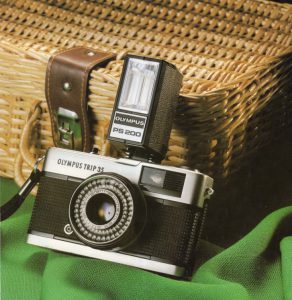
How good could it be? This is a simple compact camera from the “electric eye” era with a large selenium meter and a limited number of shutter speeds, after all. There were tons of cameras like this made over the years, so despite the overwhelming evidence that the Trip 35 was something special I had to find out for myself.
For starters, the Trip is small, but not too small. This was a camera that was designed to be packed into luggage and taken on vacation, so portability was factored into it’s size. Of course Olympus already had their well known half-frame Pen series, and the Trip 35 in someways looks like a full size Pen. At a weight of 390 grams, the camera is light enough to not be noticeable when hanging from a wrist strap, but isn’t so lightweight as to feel cheap.
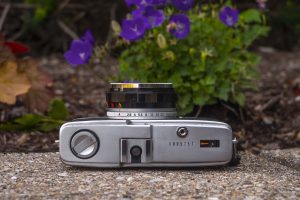
The overall design of the camera has a very minimalist Japanese look to it. By that I mean, no unnecessary bumps, curves, or protrusions. The top plate is very straightforward featuring a rewind knob with fold out handle, the flash hot shoe, cable threaded shutter release, and automatic resetting exposure counter window. The shutter release on this one is chrome as were all the earlier Trips. At some point in the late 70s or early 80s, the shutter release was changed to a black plastic type, but otherwise looked the same.
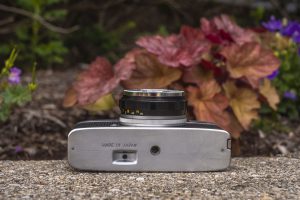
Flip the camera over and the bottom has the rewind release button and a centrally located 1/4″ tripod socket. While I always appreciate the inclusion of a well thought out tripod socket, the lack of a Bulb or any shutter speed slower than 1/40 likely suggests that not too many Trips ever saw use on a tripod.
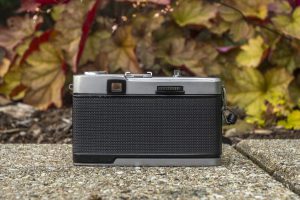
The back of the camera continues with the same squared pattern vinyl body covering from the front and features a rectangular viewfinder window and to the right, the film advance wheel.
This style of rear film advance wheel was a hallmark of most of Olympus’s compact cameras. It first appeared on the original Olympus Pen in 1959 as a way to make the camera as inexpensive as possible and continued with the Trip and the later XA-series of cameras.
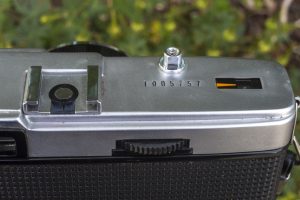
Although a cost cutting measure, in reality it works quite well, as two quick left to right swipes of your right thumb across the wheel is enough to advance the film one full exposure while simultaneously cocking the shutter. I can’t honestly say that a film advance lever would have been much faster.
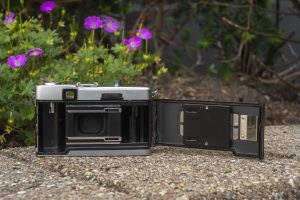
Loading film into the Trip is an uneventful affair. There is a small release on the bottom of the camera’s left side which unlocks the door. Film loads from left to right onto a multi-slotted fixed take up spool.
Despite it’s economy pricing, the film compartment is as good as cameras costing quite a bit more with it’s over sized and dimpled film pressure plate which helps maintain film flatness while decreasing resistance, and even featuring a metal spring on the door to help keep the cassette stable while shooting. In the previous image to the left, you can see this camera’s degraded light seals which like many cameras of the era, needed to be replaced before I could shoot it.

Although lacking a rangefinder or any other kind of optical focus aide, the Trip 35 has a simplified focusing system that uses 4 click stops for various types of photography. At each click stop is an icon which can be seen through a small window from within the viewfinder. The four stops represent the following distances:
- Closeup – 1m (3.2 feet)
- Portrait – 1.5m (5 feet)
- Group – 3m (10 feet)
- Scenery – Infinity
Although not visible from this angle, a focus distance scale with marks in meters and feet is on the opposite side of the lens, visible for the bottom in case you don’t like the icons.
Combined with the wide depth of field offered by the 40mm D.Zuiko lens, guessing focus in most brightly lit scenes is very easy and quite a bit faster than had the camera come with a rangefinder.
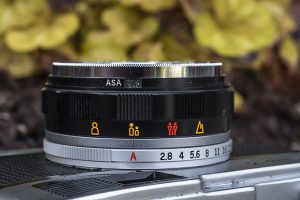
Also visible from this angle is the aperture scale ring which enables full and partial auto exposure modes. Turning the inner ring to the A position allows the camera’s meter to select one of the two shutter speeds (1/40 or 1/200) and any range of f/stops from f/2.8 to f/22 to get the exposure right. If there is insufficient light to make a properly lit exposure, a red flag will appear in the viewfinder window and the shutter release will be locked.
For flash photography, or those who want a little more control, you can choose partial auto exposure mode by turning the aperture ring to any position from 2.8 to 22. In each of these positions, the auto exposure system is not fully deactivated, it will still measure light output and select an appropriate f/stop up to that point. So for example, if you manually select f/16, and the exposure meter thinks that f/8 is the right choice, that’s what it will use. In this partial mode, the shutter speed is fixed at 1/40 and cannot be changed. If you require a 1/200 shutter speed in manual mode, there are articles online showing you how to open the camera and modify it to do so . Without this modification however, the camera should not be used for fast action shots in manual mode.
Lastly, at the very front of the lens, is a ring for setting the ASA film speed for the meter. Earlier Trips were limited from 25-200, but were later increased to allow ASA 400 film to be used.
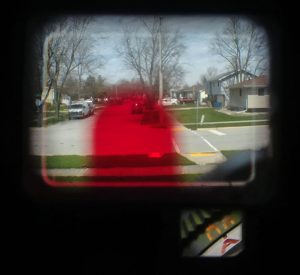
The viewfinder is large and bright, showing projected frame lines for the 40mm frame. The frame lines do not automatically correct for parallax, so there are hash marks to indicate the frame at close focus.
In an effort to make the camera as small as possible, the viewfinder is a bit too close to the lens which causes it to protrude into the viewfinder in the bottom right corner.
Below the viewfinder is a peep hole that allows you to read both the selected focus distance and shutter mode at the same time. In the previous two images, the camera is set to Portrait and Auto.
Lastly, when there is insufficient light to properly expose an image, a red flag will appear in the viewfinder window and the shutter release will be locked, preventing you from making an exposure. This could be a problem for people wanting to use faster film as the fastest speed supported is 400 but for most general shots it should be fine.
The Trip is very easy to use and I’ve found it’s best with cameras like these to not overthinking these, and to use them to their strengths, which is exactly how I intended to use it.
For my first roll through the Trip, I loaded in a fresh roll of Fuji 200 and took it with me to the Chicago Bears training camp prior to the 2019 season, and like the Bears season turned out to be, that first roll was a disaster as I foolishly used the camera without replacing the light seals and the entire roll had major light leaks in every single image. Whoops!
Into the repair queue went the camera, and after having a free weekend to replace the degraded light seals with some new ones, I loaded in another roll of Fuji 200 and took some fall pictures with it.

There is a reason the Olympus Trip 35 almost universally receives constant praise and was in production for over a decade and a half. This is an immensely fun and easy to use camera that delivers excellent results, and perhaps shocking to no one, my results were excellent too.
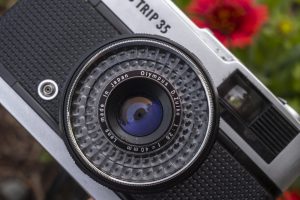
I left the camera in Auto mode for the entirely of it’s first two rolls and tried to use it as closely as possible to how it’s target audience would have. Looking at the images I got, they are all properly exposed, sharp across the frame, and show no signs of optical flaws common in lesser cameras. A tiny amount of vignetting was evident in a few images, but nothing that should bother anyone. As is the case with any lens marked Nikkor or Rokkor. Olympus’s lineup of Zuiko lenses make spectacular images.
The Olympus Trip wasn’t the first at anything except possibly being the first truly capable point and shoot camera and for that, has quickly become one of my favorite cameras in all of my collection. As much as I’d love to tell you that a folding plate camera from the 1920s or some quirky 1950s SLR is going to be my “go to” camera when I want to shoot film, the reality is cameras like the Olympus Trip will get the call far more often than 95% of what’s in my collection.
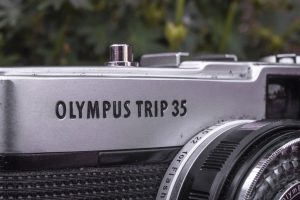
I could probably come up with a few nitpicks about the camera like for example the cramped viewfinder that is blocked by the lens in the bottom right corner, or being limited to only 2 shutter speeds and not having a true manual mode, but frankly, if Olympus had changed any of those things, it likely would have negatively affected the success of the camera. Having such a simple shutter meant that it was more reliable and cheaper to produce. Had the camera cost even as little as $10 more, less people would have bought it and it likely wouldn’t have been in production for as long. If there were more features it might have not appealed to the entry level consumer like it did.
The Olympus Trip 35 is a perfect example of “less is more” and in this case, it is WAY more. As this article tops 3400 words, I regret to say that I have nothing new to add to the countless number of positive articles about this camera that already exist.
They’re all right. This is a wonderful camera and one I strongly recommend you check out!
Related Posts You Might Enjoy
Olympus Pen EE-S (1962)
Minolta Hi-Matic E (1971)
External Links
http://camera-wiki.org/wiki/Olympus_Trip_35
https://www.casualphotophile.com/2016/10/03/olympus-trip-35-camera-review/
https://kosmofoto.com/2017/03/olympus-trip-35-review/
https://www.35mmc.com/05/05/2018/olympus-trip-35-taught-little-bit-spontaneous-photographically-andrew-morang/
https://emulsive.org/reviews/camera-reviews/olympus-camera-reviews/the-olympus-trip-35-vs-the-olympus-xa2-in-the-field
https://www.kenrockwell.com/olympus/trip-35.htm
http://photo-utopia.blogspot.com/2008/03/olympus-trip-35.html
https://lewiscollard.com/cameras/olympus-trip-35/
https://schneidan.com/2016/07/01/olympus-trip-35/
https://wycameras.com/blogs/news/review-olympus-trip-35
http://mattsclassiccameras.com/rangefinders-compacts/olympus-trip-35/
https://www.kpraslowicz.com/2004/07/08/olympus-trip-35-1200th-modification
https://www.flickr.com/groups/olympustrip35/
Like this article? Share it!
- Click to share on Facebook (Opens in new window)
- Click to share on Reddit (Opens in new window)
- Click to share on LinkedIn (Opens in new window)
- Click to share on Twitter (Opens in new window)
- Click to share on Tumblr (Opens in new window)
- Click to print (Opens in new window)
- Click to share on Pinterest (Opens in new window)
Now I understand why this camera is a consistent good seller on That Auction Site. For your readers who may not know, the letter preceding the name “Zuiko” on Olympus manual focus lenses indicates the number of elements, with A = 1, B = 2, etc etc through H = 8 (found on the H. Zuiko 35mm f2.0 in the OM series, which I think is the most complex prime lens Olympus made). . Early manual focus Nikkors of the pre-AI variety use a similar scheme, but the letters are based on Latin or mathematicians’ designations for the number of elements: T = tri, Q = quadra, P = penta, H = hexa, S = septa, on up thru D = deca.
Thanks for the feedback Roger, perhaps this would make for an article of it’s own as Minolta did it with their lenses too.
First Letter (no. of groups): T=3; Q=4; P=5; H=6; S=7; O=8; N=9. Second Letter (no. of elements): C=3; D=4; E=5; F=6; G=7; H=8; I=9; J=10; K=11; L=12.
For example, the 58mm f/1.2 MC Rokkor – PG contained 7 elements in 5 group
I have 3 Trips and really must rationalise and sell a couple of them
String pull Kodak first successful point and shoot?
Thanks Mike and Roger for the Groups/Elements codes here. I knew Nikon, but not theothers
Great article! There was one change/variant you didn’t mention – the all black model produced for two years between 1968-1969. I have three Trips, one early Chrome button, one later black button and, of course, the Trip Noir, which is my faithful travel companion. I’ve even run some infrared film through it (successfully) – it truly is an exceptionally capable camera.
Mike I’ve had a few trips in my time and found them so easy and fun to use. There is a one thing to look out for when buying one, check the red flag pops up when you cover the meter with your hand indicating insufficient light – if it doesn’t show and the shutter still fires then you may have a problem. Also i thought the apature settings were mainly there for when a manual flash was attached and the user then sets the appropriate f stop for the subject to distance coverage needed.
Am I alone in thinking that the Trip 35 is the full frame version of the Pen EES2? I have both.
Olympus’s design theory back then shared a similar family resemblance across many models. I am certain that was intentional! 🙂
Like this Post? Let me hear your thoughts! Cancel reply
Olympus Trip 35 – A Fully Mechanical Vintage Point and Shoot Camera (Review)
- May 31, 2022

Cool to see a new review of the old analog Olympus TRIP 35 (here on eBay) ! Analog Insights writes:
In today’s episode, Jules, Paul and I review the Olympus Trip 35 – a beautiful, compact 35mm viewfinder camera with built-in selenium light meter, an excellent 40mm f/2.8 Zuiko lens and an automatic exposure mode. The camera was first introduced in 1967 and built until 1984. According to most online sources, about 10 million units were produced in these 17 years, yet this number is likely to include later plastic versions with some form of Trip branding. Looking at the actual serial numbers, it is more likely that Olympus built around 5.4 million units of the Trip 35. Paul is also known as Trip Man (https://www.tripman.co.uk), selling refurbished classic Trip 35 cameras and accessories online out of England. He is a true authority and thus my perfect guide to this wonderful little camera. I cautiously reached out to him asking whether he would be available for a conversation via Zoom and he decided to spend a short spring vacation here in Munich. We used the opportunity to take the Trip 35 out on a photo walk in Munich’s Westend district shooting Ilford Pan 400 on a cloudy day. Paul could use the Trip 35 here in Munich as it was originally intended – as a light, easy-to-use travel camera that lets you explore the world, focus on your subject and nothing else. I also took the camera out together with Jules on a photo walk around dusk in a former industrial area. To match the beautiful golden light, we shot a roll of Kodak Gold 200 rated at ISO 160 and got some excellent results as well. Let’s get started and learn more about the Trip 35.
**This post contains affiliate links and I will be compensated if you make a purchase after clicking through my links.
As an Amazon Associate I earn from qualifying purchases
- previous post: a bit of everything…
- next post: Leica and Panasonic Signed Strategic Comprehensive Collaboration Agreement, and Develop “L2 Technology” as Symbol of the Collaboration
- Olympus Trip 35
- Edit source
- View history
The Trip 35 is a fully-automatic 35mm compact camera , manufactured by Olympus from 1967 [1] to 1984, during which time over ten million units were sold. [1] (This oft-quoted figure is likely to have included later plastic-bodied Olympus cameras with Trip branding, as the original Trip 35 had serial numbers going up to around 5,400,000.) [2] The auto-exposure mechanism is effectively solar-powered by a selenium cell surrounding the lens, and consequently the camera runs entirely without batteries. Until June 1978, the shutter button was silver-coloured metal. After that date, all Trips had a black plastic button.
- 1 Auto-exposure mechanism
- 3 Viewfinder
- 4 Common failure and fix
- 5 References
Auto-exposure mechanism [ ]
With the aperture ring set to "A", the camera operates as a program automatic with a working EV range of 8.32-17.4 at ASA 100. [3] Half-pressing the shutter-release button locks the exposure with both the aperture and shutter speed (of which there are only two, 1/40 and 1/200s) fixed by a delicate but accurate mechanism. As explained by one repair page ,
The combination of aperture and shutter speed that the exposure mechanism chooses depends on the amount of light available. The precise amount of light that triggers a change of the shutter speed is not documented in the user manual, but it is believed to be around EV 13. When brightness of EV 13 or more is detected, the Trip 35 will increase the shutter speed to 1/200 sec in preference to using a smaller aperture, and use a narrower aperture as light levels increase from there, presumably to avoid the diffraction effects that affect all 35mm cameras below f/11. [4] Below EV 13, it will use the 1/40 sec speed and widen the aperture for lower light levels. The camera will refuse to fire if there is not enough light, with a red plastic flag appearing simultaneously in the viewfinder. This mechanism makes it impossible to make the error of shooting with the lens cap in place.
When the aperture is set manually (primarily for flash photography), the shutter speed is set to 1/40th of a second. However, the meter is still active even in this "manual" mode. Setting the aperture manually merely sets the widest permissible aperture, and the auto-exposure mechanism may still choose to set a smaller aperture than this if it sees fit. [4]
Other than this, the camera offers no controls for setting exposure manually, though one can easily set exposure compensation by changing the film ASA dial to a higher or lower value.
The Trip 35 has a 40mm f/2.8 Zuiko non-interchangeable lens, with four elements in three groups. This lens has a reputation for being extremely sharp, even in the corners. The lens provides simple zone-focusing with 4 cute distance symbols marked on the top-left of the lens. These correspond to the real distance markings on the underside of the lens: 1 meter, 1.5 meters, 3 meters, and infinity.
Viewfinder [ ]
The viewfinder is an albada-type, with parallax markings for closer focusing. The windows are made of plastic. There is a second, very small window under this, nicknamed the "Judas window", which shows the current aperture setting and distance symbol which are on the lens barrel.
A small red flag will appear in the viewfinder if the auto-exposure mechanism decides there is not enough light and refuses to fire.
Common failure and fix [ ]
Although Trip 35 units are considered to be well-built and mechanically reliable, many vintage units are experiencing a similar symptom: stuck or sticky aperture.
Identification of misbehavior: On a normal Trip 35, the aperture hole must automatically retract to minimum f/22 whenever shutter button is not pressed. Set the lens to different manual aperture setting and press the shutter, the aperture bore should open to different size accordingly and retract to minimum as soon as the shutter button is depressed. If the aperture does not respond, get stuck somewhere in the middle, then the aperture assembly has a lubrication problem.
The following webpage described the remedy in detail: http://www.thermojetstove.com/Trip35/ . However, there are a few steps that can be improved.
1. It's not necessary at all to open the upper cover to take out the aperture assembly. Keeping the top cover in place has 2 advantages: improved handling and what's more important, top cover is the best position to draw reliable referencing dots which is explained later.
2. When disassembling upper cover, it's not necessarily at all to have the rewind crank removed. simply lift the handle and rotate, and screws will expose.
3. Since focus in this model is done by rotation of screw type front lens element, positioning is absolutely crucial and messing up will be very painful. The online article documented this step however is confusing. The detailed steps should be as follows:
1. Remove the outer ring while having the focus ring set to infinity ('Mountain') 2. Use a marker pen to mark the position of 12 o'clock on plastic edge of front lens. This dot is temporary and shall be removed in step 4. For accurate matching, it's best to use a ruler to mark another spot on metal top cover in a line along the diameter. (Call it 1ST DOT for reference) 3. Rotate the front lens fully clockwise till the bottom(in the article, the term 'the whole way' is really confusing and caused big trouble for me). Then, again using a ruler, draw another dot on metal top cover (2nd dot) along the center and the marked spot on front lens, . 4. Remove the mark on the front lens. 5. When reassembling front lens, first double check the focus ring is in position of infinity, then screw the lens in fully clockwise to the bottom. Draw another dot on the lens edge along 2nd dot and lens center. Let's call it 3rd dot. 6. Rotate the lens counter-clockwise until 3rd dot is aligned with 1st dot. 7. Reinstall front ring, be sure to insert the extend directly into the pit in focus ring, tighten 3 screws and make sure outer ring (With Olympus Zuiko Made in Japan mark) rotate symmetrically with focus ring.
Follow this procedure, factory-level focus accuracy should be retained after a lubrication maintenance.
References [ ]
- ↑ 1.0 1.1 Olympus' history of EE-equipped cameras
- ↑ Serial numbers collected by Flickr group
- ↑ Specifications in the user-manual.
- ↑ 4.0 4.1 See the Trip 35 program graph , and the explanation in this thread .
- Olympus Trip 35 - Sample Images
- Olympus Trip 35 Users - Facebook Group
- Salerno's Olympus Trip 35 age identification page.
- Jim Simon's Trip 35 page
- Lionel's Olympus Trip 35 page in French at 35mm-compact.com
- Olympus Trip 35 page at Retrography.com by Simon Simonsen, Denmark
- Manual for Olympus Trip 35
- Olympus Trip 35 group on Flickr
- A modification that allows a 1/200 shutter speed with manual aperture control
- Illustrated instructions for repairing a Trip 35
- Olympus Trip 35 short intro and use with Kentmere 100 film
- Trip 35 in the Olympus Global History
- This is a trip at Classic Cameras by RaúlM.
- Video Manual by Shawnee Union
- Olympus Trip 35 Instruction Manual in English.
- 1 Radioactive lenses
- 2 Helios-44
- 3 Soviet Factory Logos
Daniel J. Schneider
Photographs, blog and reviews by a film photographer
Olympus Trip 35: Every bit as good as its reputation
I didn’t just stumble on the Olympus Trip 35. I knew all about its excellent reputation as a sharp, simple camera with a good pedigree.
I’m fairly certain I first heard of the Trip 35 on the the Film Photography Podcast some years back, when the hosts were going through a bit of an obsession with the little powerhouse.
It’s the 1960s equivalent of a point and shoot — much more than a box camera, but almost as hands-off as can be. Set the ISO and the focus range, and fire away.
I mentioned the Trip 35 back in February , and discussed a little about production numbers and dates, etc. The important parts are: black ones were only made for a couple years and tend to command much higher prices, especially in good shape — but they’re the same as the silver ones underneath the enamel.
Description

The Trip 35 is a small camera, just a little larger than the later Olympus 35RC , and fairly lightweight. It still feels good, though, in line with many other cameras of its era. Though it has some plastic in it, it is primarily a metal camera with all that vintage solidity.
Being a product of an era when high standards of quality seemed to apply across the board, it’s a whole lot better than one might expect today based on the quality gulf between high-end and low-end, which started to broaden noticeably in the 1970s and is now rather abyssal. The lens is exceptionally sharp, the auto-exposure system is at the top of its class, and the viewfinder is bright and accurate.
The lens is a 40mm f/2.8 D.Zuiko — a four-element design that bests a lot of the Trip 35’s direct competitors’ three-element lenses. While it’s not as fast as some of the f/1.9 and f/1.7 lenses in the pack, the sharpness is tough to beat.

The light meter uses a selenium photovoltaic cell, with a large light-gathering matrix surrounding the lens. The Trip 35 requires no batteries to operate, but if the meter dies, the camera will not function in auto mode.
The auto-exposure system features only two shutter speeds — 1/200 second and 1/40 second. In auto mode, it hunts through apertures at 1/200 in an attempt to make a proper exposure, and then slows down to 1/40 to continue the hunt if necessary. If a proper exposure isn’t possible at 1/40 second and f/2.8, a translucent red flag will pop up in the viewfinder. Otherwise, the exposure is made.
Looking through the viewfinder, you’ll notice a simple brightline frame with some parallax correction marks. It’s not huge, but it’s big enough, and it’s bright enough, too. Below the main viewfinder is a tiny prism that adds a view of the markings on the control rings on the lens barrel so you can see the aperture and focus.

On the lens barrel you can set the film speed (from ASA 25 to 400) by turning the 43.5 millimeter filter ring, and also the aperture for flash mode. The aperture ring has an “A” for auto mode, and the rest of the fixed aperture settings are meant to pair with the subject distance to match a flashgun’s guide number. When a manual aperture is selected, the shutter is locked at 1/40 second. The shutter can be permanently modified to stay at 1/200 , but this will limit the camera’s low-light abilities.
The third setting on the lens barrel is the expected one — focus. The Trip 35 uses zone focusing rather than a rangefinder. The four pictographs correspond to fairly standard distances: a little head and shoulders for 1 meter, two little heads and shoulders for 1.5 meters, two full-length people and a kid for 3 meters, and a mountain for infinity. In case you forget (or just prefer numbers to pictographs), the opposite side of the focus ring has distance markings. The pictograph is what gets shown in the viewfinder, though.
The shutter release button is threaded for a cable release. The rewind knob has a flip-out crank, and there is a frame counter on the right shoulder. The film advance is a thumbwheel on the back edge of the top cover behind the shutter release button.

Be sure to push in the take-up spool release button on the bottom cover before rewinding, and rewind before opening the film door with the small silver latch tab on the bottom left corner of the camera.
There is a standard tripod mount on the bottom, and the top features a hot shoe (and there’s a PC sync socket on the front cover, below and to the right of the lens).
And that’s about it — there just isn’t a lot of technical detail to the Trip 35, but there is elegance in simplicity.
With that, let me tell you what I like about it.
I didn’t expect to like the Trip 35 so much at first. I mean, hearing it talked about and seeing so many articles, I expected it to be just another 1960s-70s rangefinder-wannabe. Don’t misconstrue that to mean I expected it to be bad — but I didn’t expect it to set itself apart.

I think I was wrong. It’s not the best camera I’ve ever used, by any means, but its euphony of size, fit and finish, function, and image quality is really pretty special.
I’m not shy about my troubles with zone- and scale-focus cameras. I have terrible luck with them, mostly because I don’t remember to focus them before I press the shutter. I don’t know that I wouldn’t have better luck if I used them (or, more likely, one of them) more of the time, but in the limited experience I have with them, I just don’t remember more than half the time.
The Trip 35, though, solves that problem for me by showing me the focus setting clearly and brightly in the viewfinder. For me, this clears the biggest roadblock in the way for me to get good images with this class of camera. And for me, at least, it was by far the biggest roadblock.
Okay, okay — the images I’m attaching here aren’t so great — but they’re meant to check the thing out: to see lens distortions and aberration, focus across the breadth of the frame, and so on. And a lot of them also are taken as opportunities for me to test out the feel of the camera.

The film counter on mine was stuck at first. In fact, it was stuck all through my testing. I didn’t figure out how to unstick it until I was writing this. I’m not sure how I managed to miss the solution — I just opened the film door with the shutter uncocked and operated the advance, and the counter reset to the “S” (for Start). Everything else worked right from the start.
I found my Trip 35 at an antique mall, and while I paid below market for it, I didn’t get a thrift-store price. I’m okay with that. I’d been expecting one to turn up in a thrift store after all the talk, but not having actually seen one in five years of trawling thrift stores for photographica, I decided to go for it. Once I had it my hands, it pretty much wasn’t going back in the cabinet.
As stated above, it’s the much-less-common black version of the Trip 35. It’s not perfect — it has a few scuffs and signs of use on the enamel. But the lens is crystal clear and everything works as it should.

I found the size exceptionally right. It’s almost as small as a camera could be and still feel like it fills my hands adequately. The arrangement of the controls is good — really good. The film advance is smooth and fast. The shutter release has just the right amount of tension.
The shutter is quiet, too. Not silent — or even quite as silent as some others — but it’s impressively quiet. I can see why it’s prized for street photography. No batteries required, easy to zone focus, and, in decent light, no fiddling with exposure. It truly becomes point and shoot.
The results are great, too. Sharp from edge to edge, no noticeable distortions, and minimal chromatic aberration. My color tests were with expired film, but the results struck me as good. Contrast on the black and white shots, taken with Ilford Delta 100, was excellent.
If I had a complaint, it would be that the Trip 35’s aperture ring is narrow enough to be difficult to operate with my big sausage fingers. But it’s not really designed to be used without a flash attached, which is something I just don’t do very often.
One minor issue I had — and it was all me — was missing a ton of pictures because I didn’t check that it was loaded. With or without film, the Trip 35 happily clicks away. I think, at one point, I took about 40 pictures and started to wonder why I wasn’t out of film. Turning the rewind knob a bit, I realized there wasn’t any film in the camera, so I loaded it and spend some time retracing my steps to re-take what I could.
The only realistic avenues for improvement with the Trip 35 would be to give it fully manual controls, or a coupled rangefinder. Those deficiencies prevent me from rating the Trip 35 a perfect five stars, but don’t take that to mean you shouldn’t try one out if you have the chance — it’s a really great little camera.
Here are the rest of the test shots I feel like displaying:

John's Cameras. A collection of interesting and old cameras.
These are descriptions of my growing collection of old film cameras together with my experience of using them. The descriptions are entirely based on a particular camera that I have before me rather than just on Interweb research.
Olympus Trip 35

When I bought this camera, the light seals had degenerated to a black sticky mass. It is extremely easy to replace these with thin self-adhesive foam.
The following is an advert for this camera from the 1971/2 Wallace Heaton catalogue:

In time the excellent Trip 35 was replaced with a cheaper to make and more aut omatic camera – the Trip AF 50. This is a plastic camera with a built in flash and auto-focus . It is a well made camera but not in the same class as the original Trip 35 to which it owes nothing but the name.
Please share this article if you enjoyed reading it:

- Share on Tumblr
Author: John Margetts
I am a keen photographer who also collects cameras. I am retired with about 50 years photography experience. View all posts by John Margetts
One thought on “Olympus Trip 35”
- Pingback: Olympus PEN EE (half frame) – John's Cameras
Leave a comment Cancel reply
This site uses Akismet to reduce spam. Learn how your comment data is processed .

- Already have a WordPress.com account? Log in now.
- Subscribe Subscribed
- Copy shortlink
- Report this content
- View post in Reader
- Manage subscriptions
- Collapse this bar
- Recent Photos
- The Commons
- Flickr Galleries
- Camera Finder
- Flickr Blog
- The Print Shop
- Prints & Wall Art
- Photo Books
- Stats Dashboard
- Get Auto-Uploadr

olympus trip 35
Meet my new baby. serial number and date of production: 2775867/ march 1971. the trip 35 is a fully-automatic 35mm compact camera, manufactured by olympus from 1967 to 1984, during which time over ten million units were sold.(this oft-quoted figure is likely to have included later plastic-bodied olympus cameras with trip branding, as the original trip 35 had serial numbers going up to around 5,400,000.) the auto-exposure mechanism is effectively solar-powered by a selenium cell surrounding the lens, and consequently the camera runs entirely without batteries. until june 1978, the shutter button was silver-coloured metal. after that date, all trips had a black plastic button. -camerapedia.
How to get serial number of my Olympus camera
The sticker on the camera came off and I need to know the serial number to process a guarantee, does anyone know a method?
Any Exif reader would do it…..or a program like Aseedsee……just check it and give you the info …….
The Best Camera is the one that you have on your hands.
Palin0_0 wrote: Any Exif reader would do it…..or a program like Aseedsee……just check it and give you the info …….
Can Adobe Photoshop do it?
The camera carries the info internally, although the method for accessing it varies by model. Check to see if your camera is among those listed:
http://www.biofos.com/cornucop/hidden.html
If adobe reads the metadata it should…but adobe Lightroom did not read the metadata……
PODS wrote: Palin0_0 wrote: Any Exif reader would do it…..or a program like Aseedsee……just check it and give you the info …….

Equivalence and diffraction-free since 2009. You can be too; ask about our 12-step program.
PODS wrote: Hi. The sticker on the camera came off and I need to know the serial number to process a guarantee, does anyone know a method?
I just checked LRC 12.2 & it showed s/n of my OM 1, M1 III & M1 II on my last trip.
I went back to a trip in 2005 & it showed my E1 & trip in 2008 showed my D3.
LRC also showed software version on all 5 cameras.
You can select EXIF & IPTC that you wish to view in LRC.
I didn't check PS 24.11but would expect same.
Hope you have found yours.
Latest sample galleries

Latest in-depth reviews

The newest version of Panasonic's Micro Four Thirds video-oriented flagship camera has arrived, and it includes features like internal ProRes RAW recording, 32-bit Float audio capture, phase-detect autofocus, and compatibility with Panasonic's Real-Time LUT system and Lumix Lab app.

The Lumix S9 is Panasonic's newest full-frame mirrorless camera. It allows users to create their own custom looks for out-of-camera colors and is the first full-frame Lumix camera aimed squarely at social media content creators.

The Sony a9 III is the world's first full-frame mirrorless camera to feature a global electronic shutter with simultaneous readout. After extensive testing of this 120 fps sports camera, to see what you gain (and, perhaps, lose).

Fujifilm has announced the X-T50, a mid-range 40MP APS-C mirrorless camera that gains image stabilization, subject recognition AF and a host of high-res video features.

The Fujifilm X100VI is the sixth iteration of Fujifilm's classically-styled large sensor compact. A 40MP X-Trans sensor, in-body stabilization and 6.2K video are the major updates, but do they make the camera better?
Latest buying guides

What’s the best camera for around $2000? This price point gives you access to some of the most all-round capable cameras available. Excellent image quality, powerful autofocus and great looking video are the least you can expect. We've picked the models that really stand out.

What's the best camera for travel? Good travel cameras should be small, versatile, and offer good image quality. In this buying guide we've rounded-up several great cameras for travel and recommended the best.

If you want a compact camera that produces great quality photos without the hassle of changing lenses, there are plenty of choices available for every budget. Read on to find out which portable enthusiast compacts are our favorites.

'What's the best mirrorless camera?' We're glad you asked.

Above $2500 cameras tend to become increasingly specialized, making it difficult to select a 'best' option. We case our eye over the options costing more than $2500 but less than $4000, to find the best all-rounder.

- Gear Patrol
- Work for us
- Advertise with us
- Feedback / Contact us
- Camera reviews
- Lens reviews
- Printer reviews
- Buying guides
- Sample images
- Editorial enquiries
- Camera search
- Camera comparison
- Lens search
- Product timeline
- Browse all products
- Community Guidelines
- My Settings
- My GearList
The Olympus Trip 35 Review: Everything You Need To Know
I’ve worked with many Olympus Trip 35s over the years and I’ve discovered the pros and cons of this brilliant little rangefinder camera!
The Olympus Trip 35 is so popular because it’s very easy to use, it has a great lens and it’s ideal for the novice photographer. Also, the Olympus Trip 35 is one of the only 35mm cameras powered by the sun, making it really handy to take on holiday with you. Since 1967 10 million units have been sold, which is a tremendous amount even today.
If you want to know how this camera compares to others, how much you should be paying, some of its common issues and much, much more then read on!
I’ve worked with a hell of a lot of Trip 35s over the last few years and I like them because they’re really simple. If there’s something wrong with a Trip 35 I usually know it pretty much instantly because they aren’t especially complicated.
I’ve sussed out all the common issues, what can be fixed easily and what spells the end for an individual Trip 35. Usually, it’s lens fungus or an unreactive aperture that means doom for this little camera.
After years of working with them, I took one to the south coast of England to do a full review and I was actually pleasantly surprised by it. As you’ll see throughout the article, there are actually some good pictures that came from this ancient camera.
Some shots were let down by the very real limitations of this camera but on the flipside, due to the brilliant 40mm Zuiko lens, when the exposure is correct, its shots are great.
There are a lot of pros and cons to this camera so it’s well worth reading up on it to figure out if it’s the right fit for you. I enjoyed shooting it more than I expected but it wouldn’t be a camera that I’d rely on regularly.
Olympus Trip 35 Specs
Format – 35mm
ISO – 25 – 400
Battery – Solar Powered Selenium Battery
Exposure – Automatic
Shutter Speeds – 40 – 200
Flash – Hot Shoe
A Brief History Of The Olympus Trip 35
Introduced in 1967 and rolling on until 1984, the Olympus Trip 35 was completely ahead of its time. Sporting a solar-powered light meter in the late 60’s was pretty special.
Of course, Olympus’ market audience was pretty obvious, being named ‘Trip’, it’s kind of spelt out for you. Strong, reliable, doesn’t need any batteries, anyone could use it, that pretty much ticks all the boxes when it comes to a holiday camera.
Incredibly, over 10 million Trips were sold (Up for debate) and of course, they’re still being bought and sold to this day.
How Does The Olympus Trip 35 Battery Work?
The Olympus Trip 35 is powered by the sun using a selenium light meter which is the ring around the lens. This powers the light meter and allows the camera to choose the shutter speed and aperture (depending on which settings you have on). This would have been very unusual in its time but the fact that it’s still reliable today is brilliant.
Is The Trip 35 Lens Good?
Yeah, the Olympus Trip 35 has a pretty good lens but I’ve got to say, there are quite a few drawbacks. The lens itself is a beautiful 40mm 2.8 Zuiko lens, it’s pretty high quality for a camera that feels like a point-and-shoot.
I’d say the main drawback is that the focus is zonal and you only have 4 options. You should be able to see above, there’s a picture of one person, then two, then a group and then a landscape symbol. These are your focus options and it’s basically, 1.5m, 2m 3m and 6m and beyond.
This does limit the camera quite a lot but you’ve got to forgive a 50-odd-year-old camera sometimes.
The focal length is interesting, 40mm is pretty unusual but it’s still just wide enough to take the kind of pictures you’d usually take when you go on your holidays. It’d probably be preferable to have a 35mm lens but beggars can’t be choosers.
The Olympus Trip 35 Compared To The Olympus OM10
It’s worth comparing the Olympus Trip 35 with the Olympus OM10 as they’re currently at similar prices.
The Olympus Trip 35 isn’t that similar to the Olympus OM10, the Olympus Trip 35 is a small point-and-shoot rangefinder and the OM10 is an SLR however, it’s good to see what the Olympus Trip 35 is like in comparison to another well-known camera.
The Olympus OM10 would provide much better shots as it has better quality lenses and more control however, the Olympus Trip is more convenient, more compact and easier to use.
How Much Is The Olympus Trip 35 Worth?
Currently, the Olympus Trip 35 is worth around $100-125 or £70-100. You can of course get the Trip 35 for less if you try bidding for it on eBay or search thrift stores and flea markets but it’s worth trying to make sure that your Trip 35 is all working correctly.
What Kind Of Photography Is The Olympus Trip 35 Best For?
The Olympus Trip 35 is unsurprisingly best for travel-type photography. This camera was made with travel in mind as it’s small, compact, strong, easy to use and doesn’t require any batteries. Otherwise, this is also a good camera for day-to-day use. Photographers like David Bailey championed the Olympus Trip 35 believing that it was an incredibly high-quality camera.
Although the Olympus trip 35 has a great lens it’s not necessarily overly accurate and it’s not easy to focus correctly so despite the fact that it has a 2.8 lens it doesn’t mean it’s very likely that you’ll be able to focus correctly close range and get the most out of that lens.
This is not necessarily ideal for more professional types of photography and is definitely better to be used in day-to-day life and travel photography.
Is The Olympus Trip 35 Fully Manual?
The Olympus Trip 35 has two settings, one is an automatic setting that chooses your aperture and shutter speed for you, it decides between a shutter speed of 40 and 200 and between apertures of 2.8 and 22.
Alternatively, you can decide the aperture and the shutter speed will be decided by the camera. All focusing is manual and all ISO needs to be changed manually.
How To Use The Olympus Trip 35
Olympus Trip 35 is a very simple camera to use once you get the hang of it, until then understanding its limitations can be slightly hard.
If your camera seems not to be working properly try to leave it in the sun for some time to effectively charge its battery.
To open the back of the camera there is a small lever on the bottom of the side of the camera which just needs to be pulled down until the back pops open.
To change the aperture just rotate the ring at the base of the lens, this ring will show numbers from 2.8 two 22. If you want to shoot in automatically then turn it all the way around until the red ‘A’.
To change the ISO you just need to rotate the ring on the outer edge of the lens until you are to the correct ISO.
In order to focus you need to rotate the black ring on the lens. The closest focus mode is portrait mode, then there is middle-range portrait row mode, next, there are people standing further away from you and finally, there is a full landscape mode.
To attach a flash you simply have to slide it into the hot shoe located on the top middle of the prism.
To shoot and wind on you just have to press the shooting button on the top of the camera and then wind the black winder on the back of the camera until you can’t wind it any further.
To rewind the film you must first press the black button on the bottom of the camera to release the film and then wind the silver winder on the top left of the camera all the way back until it feels loose.
Common Faults Of The Olympus Trip 35
As the Olympus Trip 35 is a very old camera it has a number of common faults, hopefully, I can shed some light on these and help you avoid them or potentially fix them.
Commonly the red flag of the Olympus trip 35 will stop working, the red flag usually shows you when the scene would be too under-exposed. The red flag would appear at the bottom of the viewfinder when you are looking through it and would usually stop you from taking a picture if it’s too dark.
Sometimes the lens won’t react correctly to light, this is a great thing to check because if this is happening then it’s not really something that you can stop and it will ruin your photos. If this is happening the only advice I can give is to put it in the sun for a bit to see if this charges your selenium battery.
It’s likely that the light seals have worn away unless you bought your camera from a reputable dealer. You will probably have to replace a small number of light seals just to ensure that you do not get light leaks, this is fairly easy and if you want to find out how to do it then go to this link .
Lastly, the lens may have fungus and if the fungus is internal and it’s not something that would be easy to fix it would be much simpler just to get another one.
Final Word On The Olympus Trip 35
This is a great camera for travel and is certainly a camera to consider using. Personally, it’s not my kind of camera, I prefer more control and this just doesn’t cut it for me!
For a camera of its age, it truly is fantastic, a solar-powered vintage wonder that can still produce some beautiful shots!
Leave a Reply Cancel reply
Your email address will not be published. Required fields are marked *
Save my name, email, and website in this browser for the next time I comment.
Hey! I've been shooting film for a very long time and throughout all of my 20's it's been my main format. In 2019 I started to buy and sell film cameras and I became a top rated seller on Etsy and eBay. I've built up a wealth of knowledge about different kinds of film cameras and their common issues.
Since I started photography I've produced a number of zines/prints and more recently made a book called 'So Far So Good'.
I started this website in late 2021 with hopes of helping out people who had been looking for similar information to me and so far, I'm really enjoying it.
Similar Posts
Is the olympus mju ii zoom 80 any good full review.
I’ve shot with a lot of Olympus Stylus Epic Zoom 80’s over the years and now I’ve got a lot of experience with this cult classic point-and-shoot camera. The Olympus Stylus Epic (MJU II) Zoom 80 is a great 35mm point-and-shoot camera that is extremely versatile with a good lens. Following the amazingly popular Olympus…
The Pentax K1000: Everything You Need To Know
I’ve shot with several Pentax K1000’s over the last few years and now I know the pros and cons of this tank-like camera. The Pentax K1000 is a robust classic SLR camera, simple and reliable, the K1000 is a joy. For a forty-year-old camera, this can still produce some beautiful shots. The K1000 is fully…
The Yashica T4 Review: Everything You Need To Know
I’ve been lucky enough to work with quite a few Yashica T3, T4 and T5s over the last few years and I’ve discovered the positives and the pitfalls of this unbelievably sharp point-and-shoot. I understand everything you want to know, how to use it, what film to use with it and the common issues that…
Is The Olympus MJU I That Good? Full Review & Guide
Over the past few years, I’ve shot with, tested and cleaned up hundreds of Olympus MJU I cameras and over that time I’ve really got to know this compact little camera. The Olympus MJU I (Or Infinity Stylus in the US) is a brilliant point-and-shoot camera with a 35mm 3.5 lens. With a weatherproof body,…
The Canon A-1 Review: Everything You Need To Know
Written – 03/08/2023 I’ve been shooting film for over 7 years and over that time I’ve used a bunch of Canon A-1s and discovered the ins and outs of this little SLR. The Canon A-1 is a classic SLR camera produced from 1978 to 1985 with shutter speeds ranging from 30 seconds to 1/1000th of…

Is the Olympus MJU II Really That good? Ultimate Guide
Over the last few years, I’ve tested a hell of a lot of Olympus MJU II’s and I’ve really got to grips with the real-life pros and cons of this cult classic camera. Along the way, I’ve discovered all of the reasons people love this camera and I’ve also got to grips with all of…
Getting the Best From the Olympus Trip 35
The Olympus Trip 35 is a cracking little camera that is capable of some stunning results from its 40 mm f/2.8 Zuiko lens. Here is a short guide for getting the best results from this camera.

The lens of the Olympus Trip 35 is as sharp as a pin. As good as this camera is it does have its limitation. The main limitation with this camera being the shutter, don’t get me wrong it works very well.
The shutter speed of this camera is limited to just two, which are 1/40 and 1/200s. If you have loaded a slow film like 100ASA and you are shooting in low light, the camera will default to 1/40th which can be a little slow for handheld shots. This, in turn, can cause a camera shake, resulting in blurred pictures. This is fine if that’s the result you are after. But if you would rather have a much sharper image, then you could use some form of rest for the camera, like a tripod, monopod, or a beanbag.
But if you’re bag is street/candid photography, that kind of gives the game away. A better option would be to load the camera with a faster film like 400ASA. This will keep you’re Trip shooting at 1/200th longer and will avoid blurred photographs due to camera shake. I hope you have found this useful, have fun with the Trip.

All the photographs were taken with my Olympus Trip 35. Long live film!
This article was written by Community member trip35snapper .
written by trip35snapper on 2011-12-01 #gear #tutorials #trip #olympus #tipster #asa #shutter #film-fpeed
munizada , bradsimpson719 , lomosapien73 , thorolvsen , jiske , mohsendavoudi , andrewdhall1988 , rulito , elcalamare , busyd , darlim , elsje , wernzteh , frantisek , lomo__lurv , uncle_jay , k_melancholy , robotmonkey1996 , gvelasco , kneehigh85 , adzfar , jawatembak & area51delcorazon .

My dad had one.

My sis got one :o))

I got mine from my Dad :) and I use it all the time so this is a handy tip to know

I have one! my O.T is my baby <3
I got my First Olympus Trip 35 a few months ago. I developed my first roll Yesterday and All the pictures were blurry. I used a Kodak Kolor 200 ASA, Is It too low? Should I use a 400 ASA?

@natalia_dep Hi 200asa film should be fine in sunny conditions, 400asa film would be a better all round film to use. when pressing the shutter button hold the camera as still as possable. Better luck next time and dont give up. Brian.
More Interesting Articles
Community gallery: first rolls with the lomomatic 110 camera.

As more and more people are getting their hands on the Lomomatic 110 here's a glimpse of the camera's versatility through the lens of some of our creative community members!
Tipster: Night-time Adventures With the Fisheye No.2

With its 170° lens mixed with features such as multiple exposure, bulb mode, and flash, the Fisheye No.2 is perfect for nights out. Here we share some tips on how to get the best low light photos with your Fisheye No.2.
Carla Dief's LomoChrome Color '92 ISO 400 First Impressions

Carla Dief has previously been featured in our magazine testing out our art lenses, as well as with her fashion and travel shoots with our film and 35 mm cameras. She's back with us today to give her first impressions on the new LomoChrome Color '92 ISO 400 film.
Three Lenses in One – Nour Triplet v 2.0/64 Bokeh Control Art Lens

Ignite the legacy of a fascinating but forgotten scientist, Ibn al-Haytham, and become a master of light with this unique lens designed for spherical aberration control on full-frame mirrorless cameras. Shipping Live Now!
Available in our Shop
Carla Dief's Trip to Thailand on Color Negative 800 Film

Carla Dief has previously been featured in our magazine testing out our art lenses, as well as with her fashion and travel shoots with our film and 35 mm cameras. She's back with us today to give her impressions of our Color Negative 800 Film.
Tipster: Multiple Exposures With the Lomo'Instant Automat Glass and a Splash of Color

Multiple exposures are a creative way to take your instant photos to the next level, particularly when you add color gels to make them even more crazy. Today we show you how to get the most out of this Lomographic technique with the Lomo'Instant Automat Glass.
Dreamy Night-time Bokeh with the Nour Triplet V 2.0/64 Bokeh Control Art Lens

From soft to razor-sharp photos, we check out Lomography's latest offering – the Nour Triplet V 2.0/64 Bokeh Control Art Lens and how it gives us dreamy bokeh for night-time shoots.
Film Photography Day Deals are On!

In celebration of Film Photography Day there are tons of exclusive discounts and fab freebies available so shop now and enjoy sweet savings before it’s too late!
Get it in our Shop
Francesca Bianchi's LomoChrome Color '92 ISO 400 Film First Impressions

Francesca Bianchi is an Italian photographer who has been previously featured in our magazine for testing out the LomoApparat, as well as with her fashion shoots with our 35 mm films. She's back with us today to give her first impressions on the new LomoChrome Color '92 ISO 400 (35 mm) film stock.
Community Gallery: Creative Portraits on Instant Film
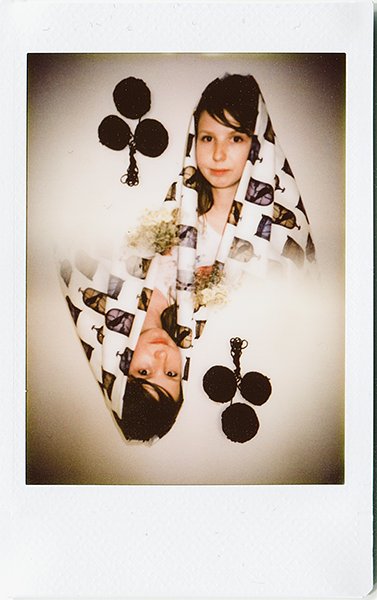
It's time to show off some instant portraits from our community members! Let’s take a look at how Lomographers have unleashed their creative potential with instant photography.
Tipster: Film Photo Inspirations For Summer

The sun's out and so should our film cameras be! In this article we've listed a few fun, classic and experimental photo styles to give you inspiration for your summer shenanigans with the help of our creative community members.
Dreamy Bokeh With the New Petzval 55 MM F/1.7 Mkii

Jump outside of your comfort zone and take sensationally striking shots with the signature bokeh of the New Petzval 55 mm f/1.7 MKII! Available in Brass, Black Brass and Black Aluminium finish!
Maria Louceiro Creates Surreal Scenes with the LomoApparat and Lomography Color-Shifting Films
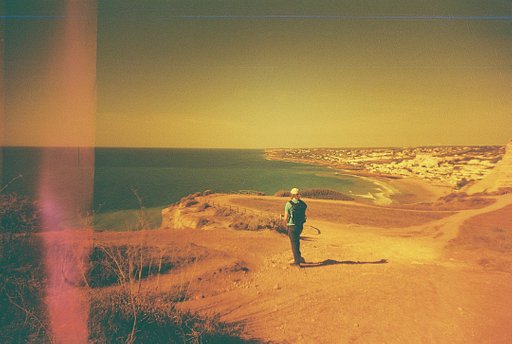
Check out Maria Louceiro's photos from her recent hiking trip and see how she uses the experimental features of the LomoApparat, along with our color-shifting films to turn the cliffs and ocean into out-of-this-world scenes.
Seizing the Sunlight with @spannerino & Lomography Cameras

In today's feature we're looking at sun-lit Australia through the lens of community member Caleb, a.k.a. @spannerino. He also shares his experience with Lomography cameras such as his constant companions the Lomo LC-A, Sprocket Rocket, and his first roll with the La Sardina.
Toby Mason on Shooting with the LomoChrome Turquoise 35 mm Film

We caught up with UK film shooter Toby Mason, better known as @fotobes, to find out how he's been getting on with our color-shifting LomoChrome Turquoise film.
Find Out More About


How To Use The Olympus Trip
April 28, 2023 By Cameras By Max
The Olympus Trip is a super popular camera among beginners to film, so here is our guide on how to use this awesome little camera, and some tips on how to get the most out of your Olympus Trip.
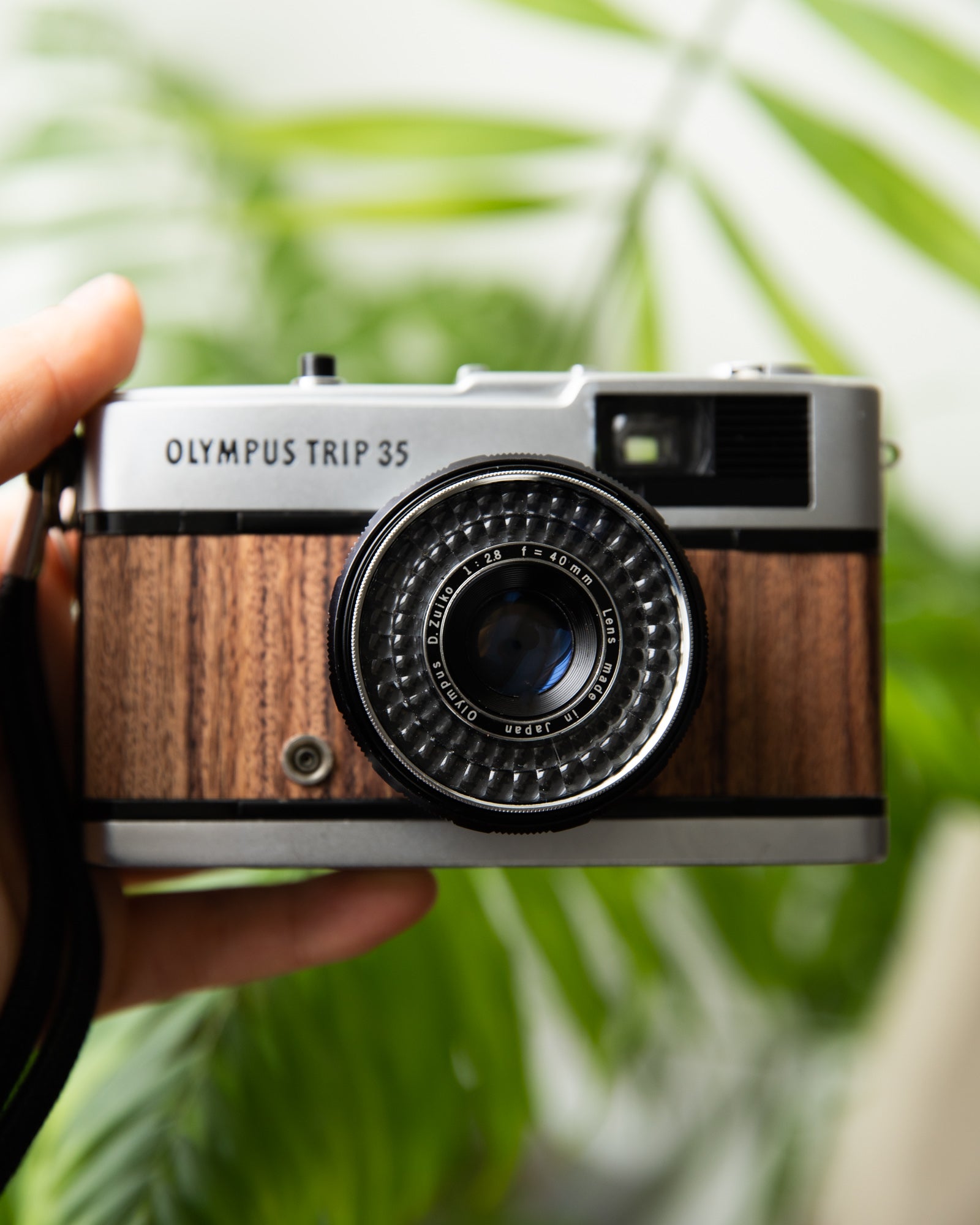
What is the Olympus Trip?
The Olympus Trip 35 was introduced in 1967, and discontinued in 1984, which is considered a long production run for a 35mm film camera. Over ten million Olympus Trip cameras were sold in this time.
Many people wrongly call the Olympus Trip a rangefinder camera, however we would classify it more as a point and shoot with zone focusing.
What features does the Olympus Trip have?
The Olympus Trip is really easy to use, and has some cool features that set it apart from other point and shoot 35mm film cameras.
- Zuiko coated 40mm f/2.8 lens : this lens is sharp, and the wide aperture makes it versatile in a lot of situations.
- Automatic settings : the Olympus Trip has two shutter speeds and aperture from f/2.8 to f/22.
- No batteries needed : the Olympus Trip is powered by the selenium meter around the lens. This is also what receives light and tells the camera which aperture is needed.
- Red flag feature : when the camera does not have enough light to take a photograph, a red flag appears in the viewfinder.
- Zone focusing : the Olympus Trip has four focus settings depending on how far away your subject is from the camera.
What are the different parts of the Olympus Trip?
The top plate.
The Olympus Trip top plate is very simple. The camera features are easy to find, making it an ideal camera for beginners. Below is a labelled diagram of the camera.
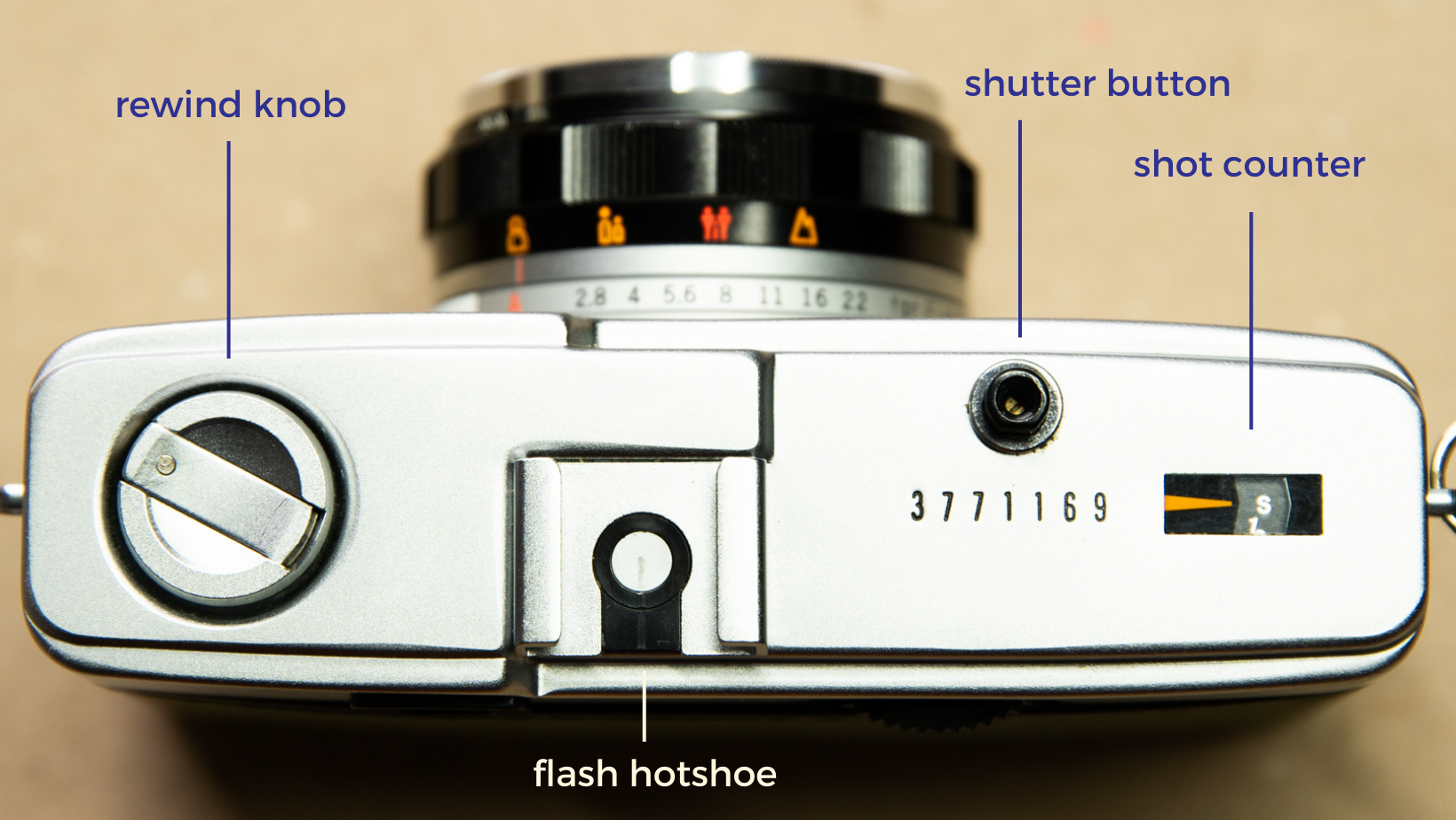
On the left of the top plate is the rewind knob (more on that later). In the middle is the flash hotshoe, used for mounting hotshoe flashes to the camera. The shutter button is the small black button on the top. On some models of Olympus Trip, this button can be silver. The small panel on the right is the shot counter that displays the number of shots you have taken.
The Olympus Trip lens holds most of the key settings for the camera , such as the ASA, focus, and aperture.

The ASA dial is set to match the roll of film that you put in the camera. For example, if you are using Portra 400, the ASA setting is set to 400.
The focus settings are simple, and known as zone focusing. There are four zones to choose from. We go through them in more depth later on in this article.
The aperture settings are only used if you are using flash. Otherwise, the camera is set to "A", which allows the camera to choose the aperture and shutter speed automatically.
The Bottom Plate
There is only one function on the bottom plate of the Olympus Trip 35: the rewind button. (And the tripod mount, technically.)

The rewind button is pressed when you are ready to start rewinding your film.
How To Load Film In The Olympus Trip
Loading film takes some practice, but it is really easy when you get to grips with it.
To load a roll of film in the Olympus Trip, first you have to open the back of the camera. To open the back of the camera, pull down this small silver tab, shown below.
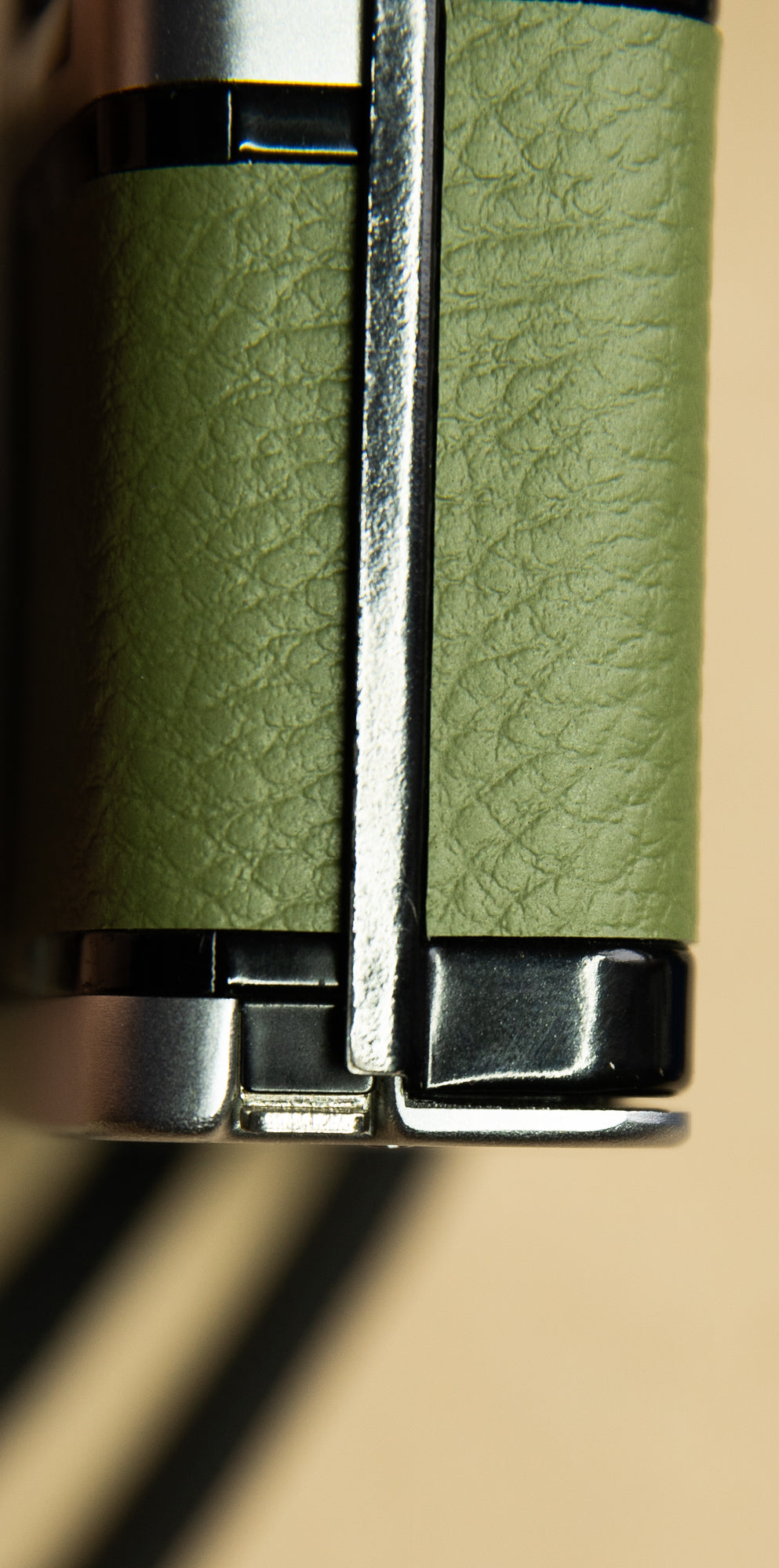
Once you have the back of the camera open, you can load your roll of film. To load the roll of film, pull the rewind knob up. The roll of film goes in with the top of the canister (the part that sticks out) at the bottom of the camera. See the image below.
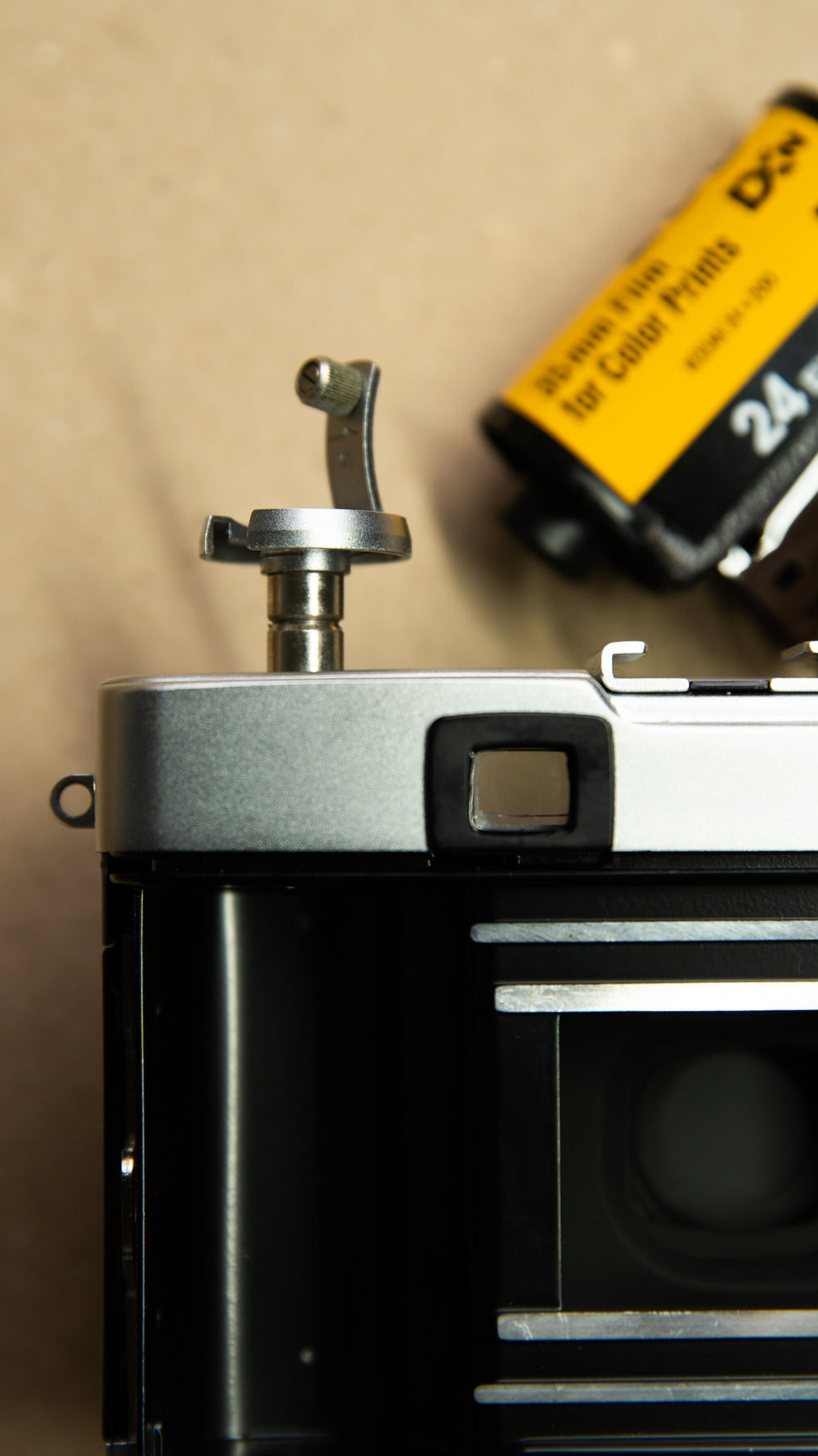
When the canister is in, as shown above, you can pull the film leader across the camera to reach the other side.
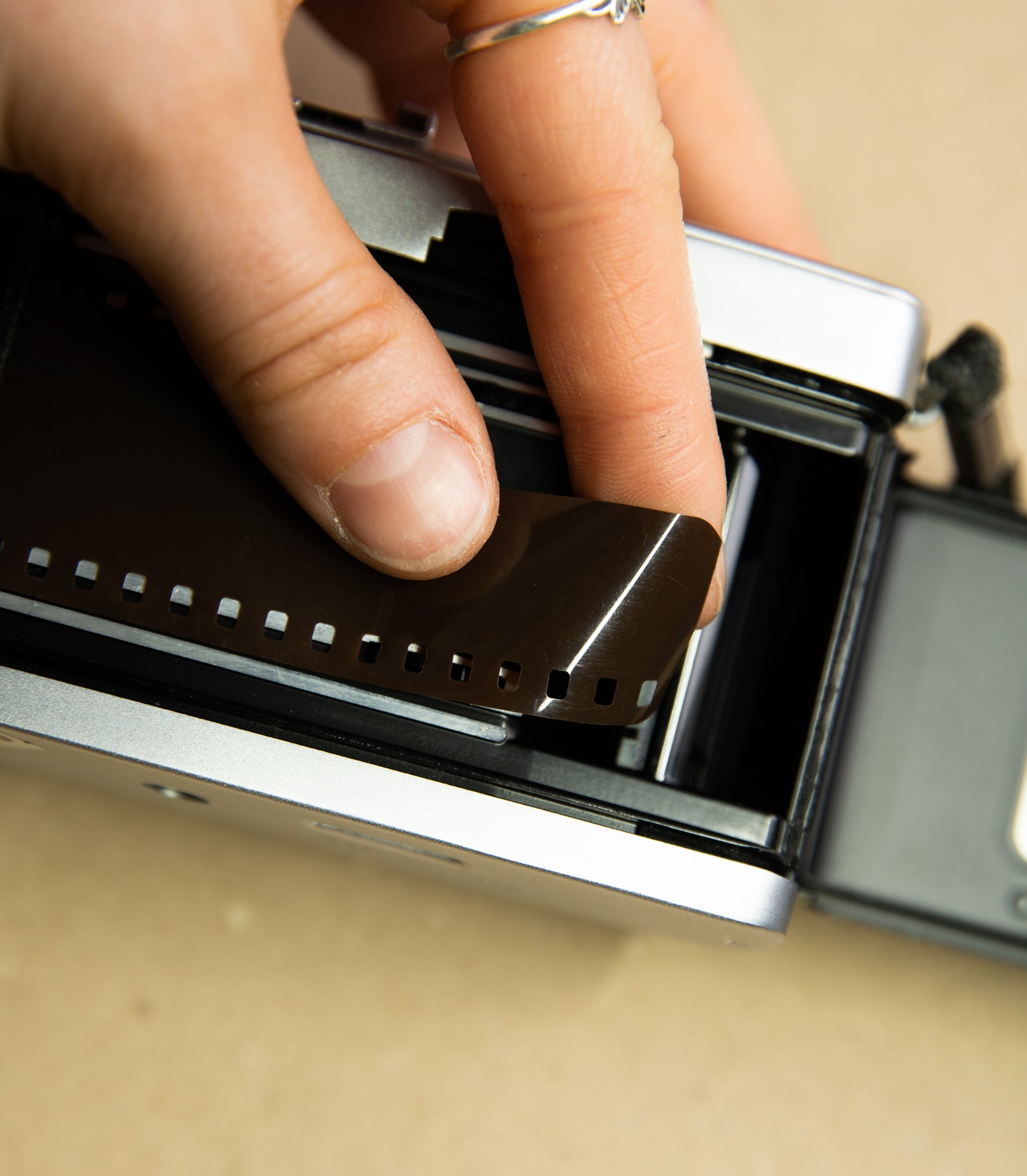
The rewind knob being put back down will lock the canister in place as you pull the film across. In order to lock the film onto the film spool in the camera, it has to go partly into one of the slots, and the notches at the bottom of the spool have to go through the sprockets on the film (the holes).
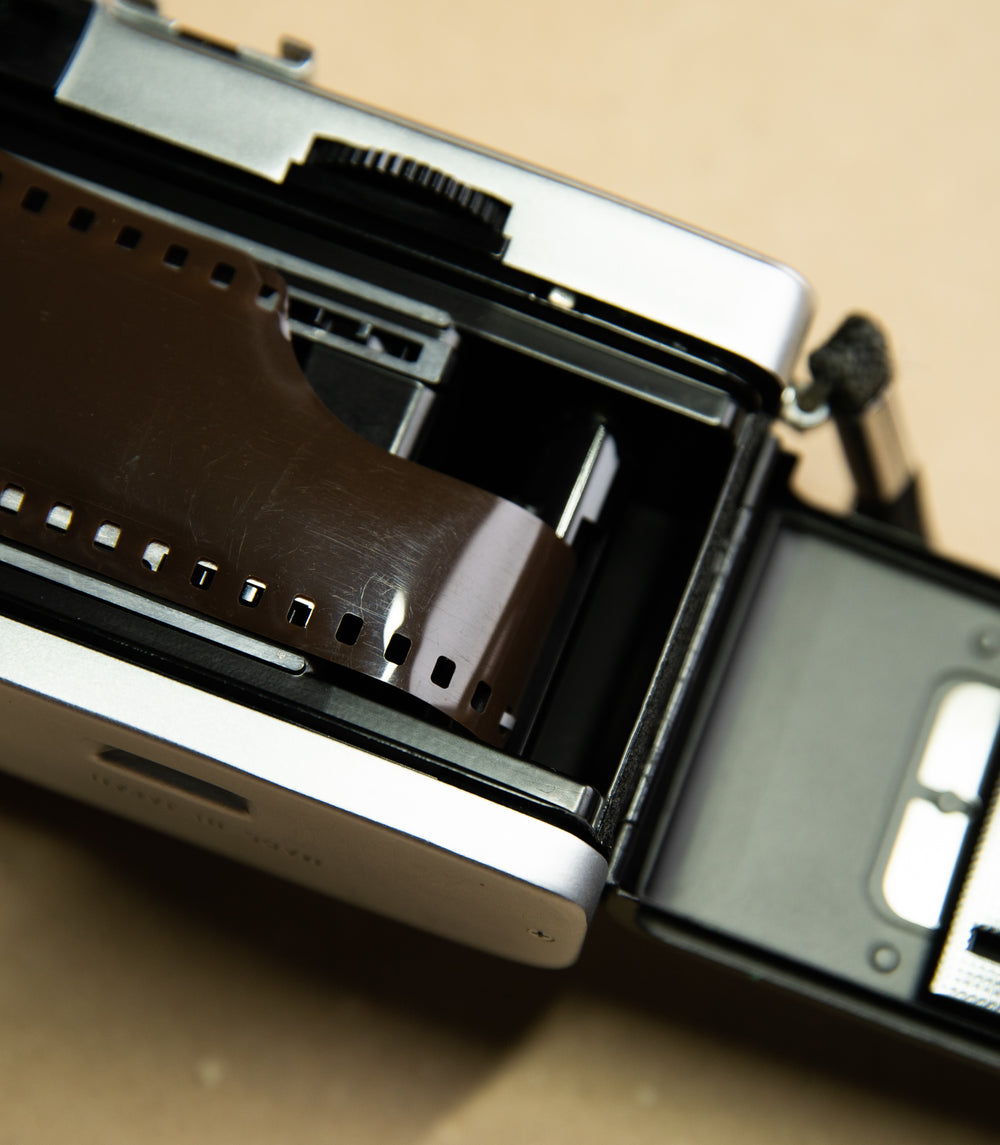
In order to be able to advance the film across the camera, you have to fire the shutter . You can do this by pointing it at a bright light or by setting the aperture setting to one of the numbers.
I recommend firing the shutter, and advancing the film (with the advance thumb wheel) twice before closing the back, so that you can make sure the film is definitely loaded correctly. As you get more confident, you can fire the shutter less times and therefore get more photos on your roll of film.
How To Take Photos With The Olympus Trip
Now you have loaded your roll of film, and closed the back of the camera, you are ready to start taking photos!
The first thing to check is that your ASA is set to the same speed as your roll of film. For example, Portra 400 is ASA 400. Or Kodak Gold is ASA 200.

When looking through the viewfinder, you will be able to see your frame lines, and the focus setting that the camera is set to. The viewfinder of the Olympus Trip does not show you where the focus is set, just which symbol you have the lens set to.
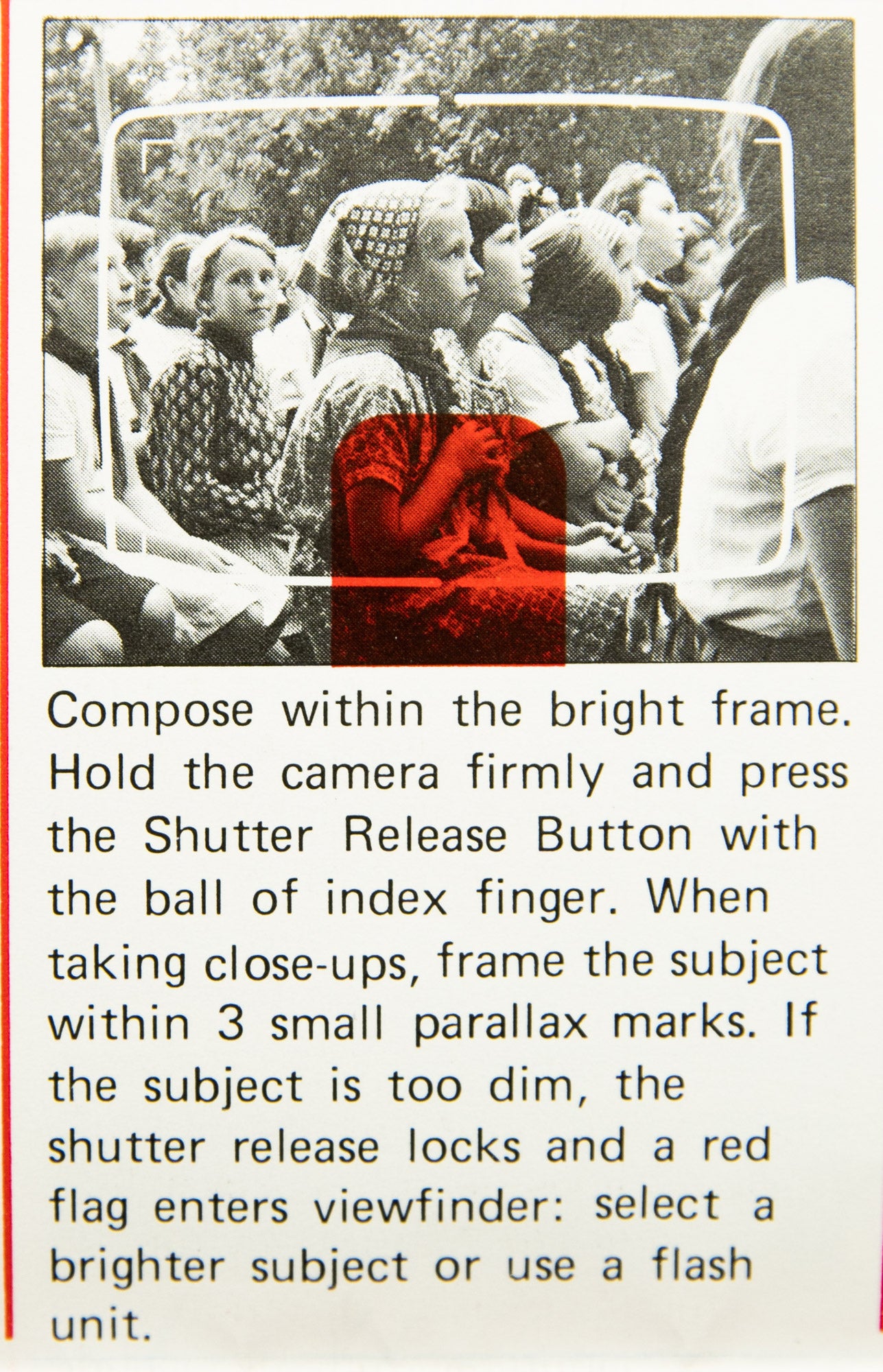
When the lens is set to "A", the camera will choose the shutter speed and aperture for you manually. If the image you are trying to take is too dark, the red flag will come up.
You can override this by setting it to one of the numbers instead, but be aware that these are intended for a flash to be used with it. By setting the Olympus Trip to a number on the lens, it reduces the shutter speed to 1/30 - that's one thirtieth of a second. So you will need to have a steady hand when doing so.
How does the film counter on the Olympus Trip work?
When you first load your roll of film, it may look as though the film counter is not moving. It takes two or three shots for the shot counter to move to the number one.
The back of the camera needs to be closed in order for the shot counter to start working.
The counter shows the amount of images you have taken, not how many you have left.
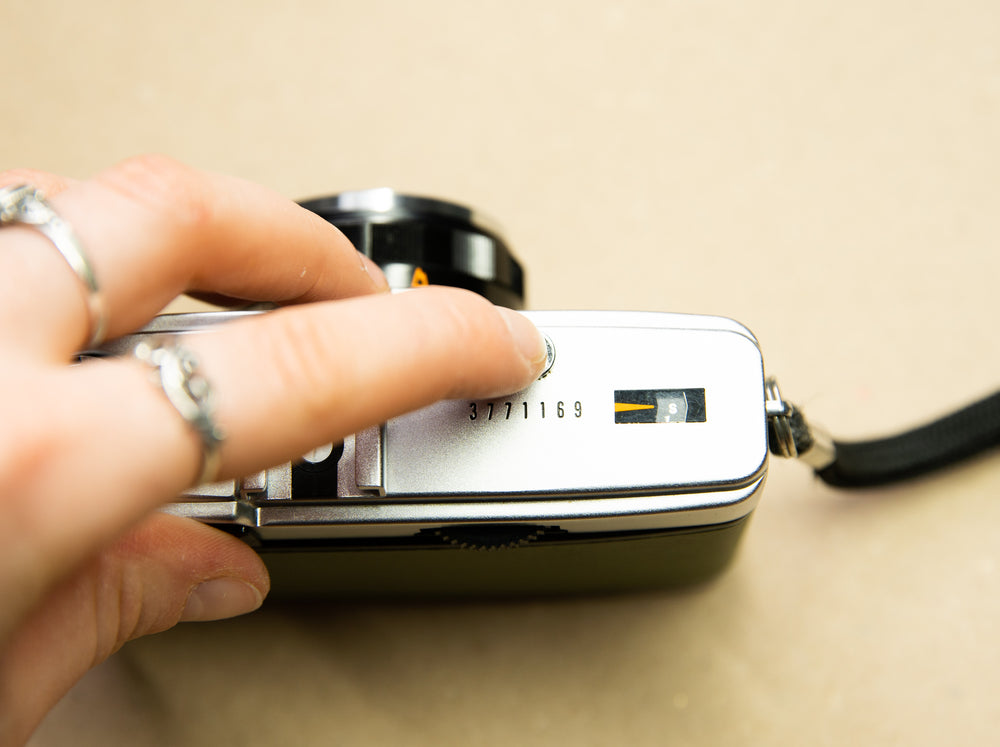
How do I focus the Olympus Trip 35?
The Olympus Trip focus settings are simple, but take some getting used to. There are four settings on the camera. The symbols for these are found on the black part of the lens, as shown earlier in the article.
The symbols are as follows:

The Olympus Trip has four focus settings . The viewfinder view does not change as you change the focus settings, so you need to know which setting is correct for how far away your subject is. Luckily, this is not hard.
The first setting has the symbol of one person. The first setting is used for close-up photographs , where the subject is less than 1 metre away.
The second setting is of two people, which is to be used for subjects from 1.5 to 3 metres away.
The third setting is a symbol of three people. This setting is used for subjects that are between 3 and 6 metres away.
The final setting is a symbol of a mountain, which is used for anything beyond 6 metres away.
If you ever forget these numbers, they are engraved on the underside of the lens (opposite to the symbols on the top).
How does the Olympus Trip 35 red flag feature work?
The purpose of this Olympus Trip feature is to stop you from taking a photograph that is not exposed enough and therefore will not be visible when developed.
When there is not enough light in your image, the red flag will pop up in the viewfinder. You will clearly be able to see it if you are looking through the viewfinder. It also blocks the shutter button from being pressed.
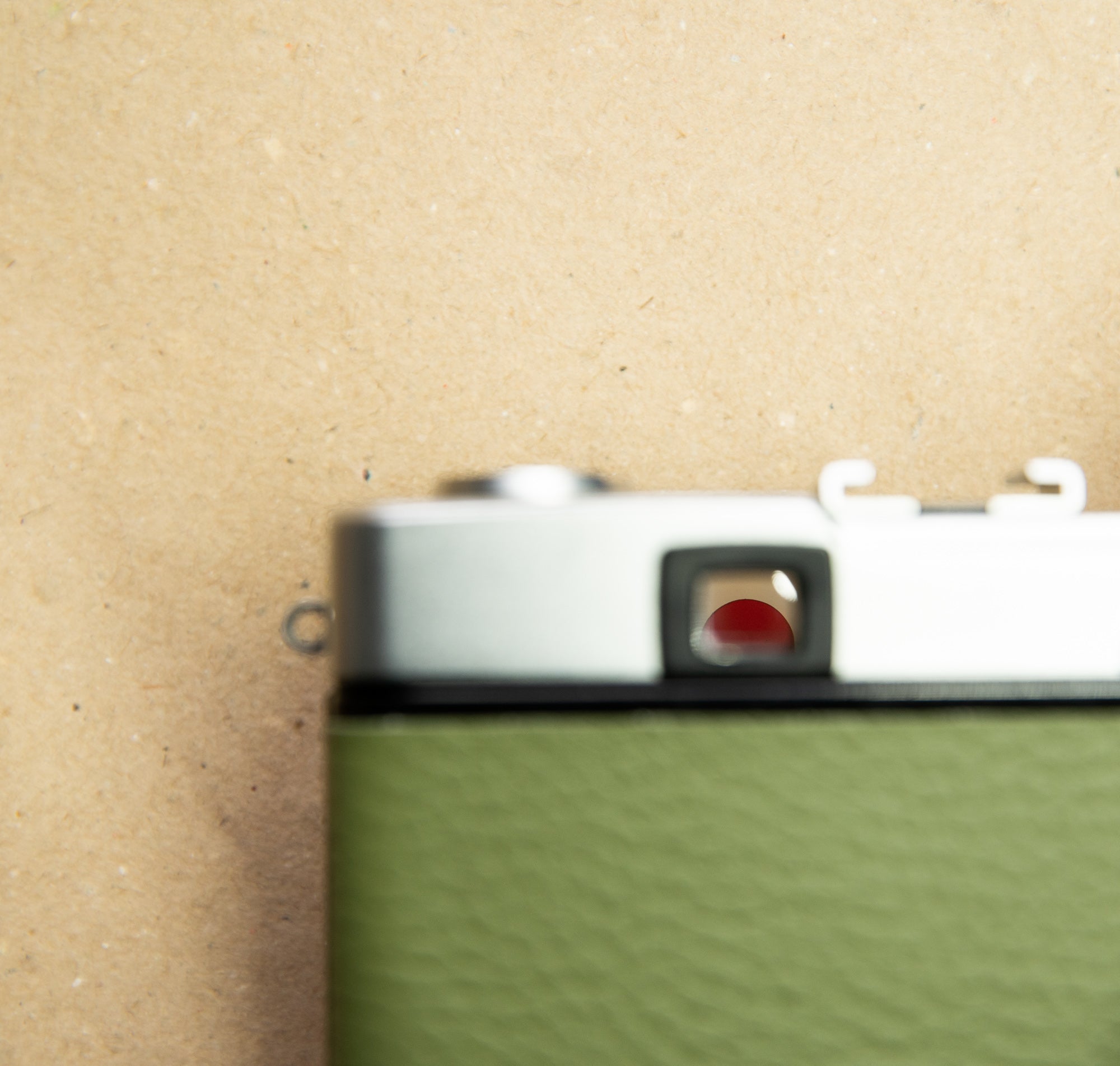
Can I use the Olympus Trip at night?
Yes, you can.
The easiest way to do this is to attach a flash to the top of the camera.
Attaching a flash to the top of the camera is easy and most flashes can be used on the Olympus Trip. It has a standard flash hotshoe on the top of the camera.
Here is an example of a flash that can be used on the Olympus Trip:
When using a flash on the Olympus Trip, there are different settings to use. These are the aperture numbers on the silver barrel of the lens closest to the camera.
The aperture you use needs to be read off of the meter table, which is usually displayed on the back of the flash unit.

You can read more about using the Olympus Trip at night here .
How To Rewind Your Film
Congratulations, you've finished your roll of film.
How can I tell if the roll of film is finished?
You will start to feel some resistance when trying to advance the camera. Do not force it, as you will snap part of the mechanism.
If you are using a 24 exposure roll of film, you will have reached the 24th shot. The shot counter should show the number 24, or near to that number. The same applies for a 36 exposure roll of film, as this will show the number 36. Sometimes you are lucky and get 37 or 38 shots out of a roll of film.
When the film will not advance any more, the film is finished.
How do I take the roll of film out?
On the bottom of the camera is your rewind button. Push this button in. It should stay in after you have pressed it once.
You can now use the rewind knob to rewind the film into the canister. Turn the knob clockwise.

Rewinding the film usually takes around thirty seconds of rewinding. You will feel when the film comes off of the spool at the end, because the rewind knob will have less resistance. Keep rewinding it until you feel certain that the film is back inside the canister.
You can now open the back and take the film out.
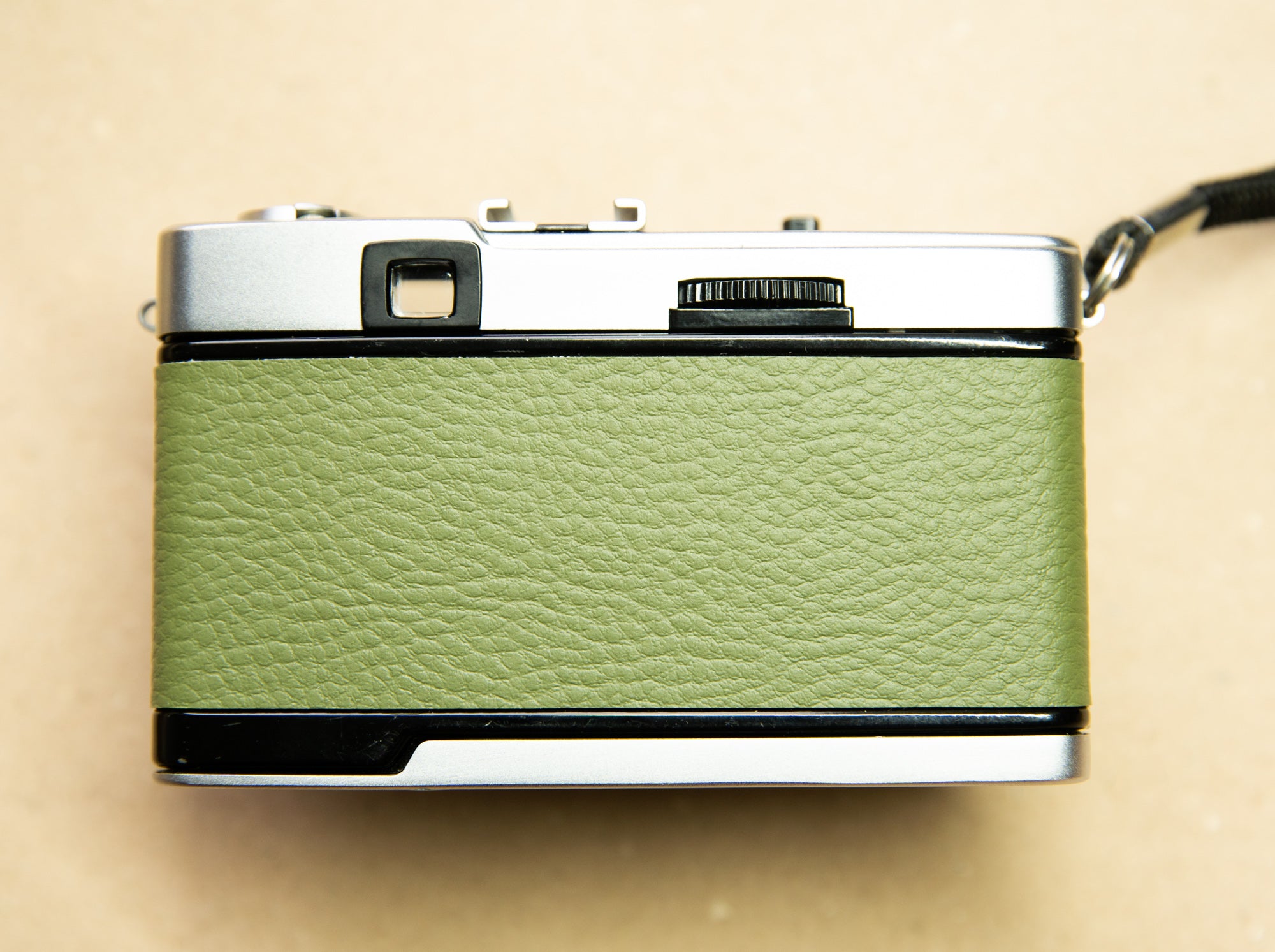
That's just about everything you need to know about the Olympus Trip 35 35mm film camera! We really recommend this camera for beginners, so we hope you have a great time using it and create some lovely images.
I think my Olympus Trip is broken; what should I do?
A lot of Olympus Trip 35mm film cameras have never been serviced in their lifetime. Because they are holiday cameras, a lot of them have sand in the mechanisms.
We highly recommend getting your Olympus Trip serviced if it hasn't been used in a while.
Maintained, these cameras can last many years, however when they have been left for decades, they can develop a few issues, such as stuck aperture blades, stuck shutter, non-functioning light meter, etc.
All of our Olympus Trip services and repairs are very affordable, so definitely consider sending it to us before deciding that it doesn't work, or putting it back in a drawer.
Shop our full range of Olympus Trips and accessories here:
Find out more about the olympus trip here:.

Featured Camera: The Olympus Trip 35

Can You Use the Olympus Trip At Night?
If you like what we do, but can't buy a camera from us, please consider buying us a cup of coffee! It helps us to keep these resources free, consistent, and accessible.
Still stuck on which film camera to buy?
Try our film camera quiz. All you have to do is answer a few questions, and then you will get a list of personalised camera recommendations.
Or send us a message on Instagram , send us an email , chat to us on our live website chat, or read some more of our blog posts!

Article written by: Max
Max is the owner of Cameras By Max. They work full-time repairing and refurbishing all the 35mm film cameras you see on the website. Their favourite camera (at the moment) is the Olympus XA, and their favourite city in the world is Edinburgh.
Take our quiz to find your perfect film camera.
Not sure which camera is best for you?
No more products available for purchase
Your cart is currently empty.

Item added to your cart
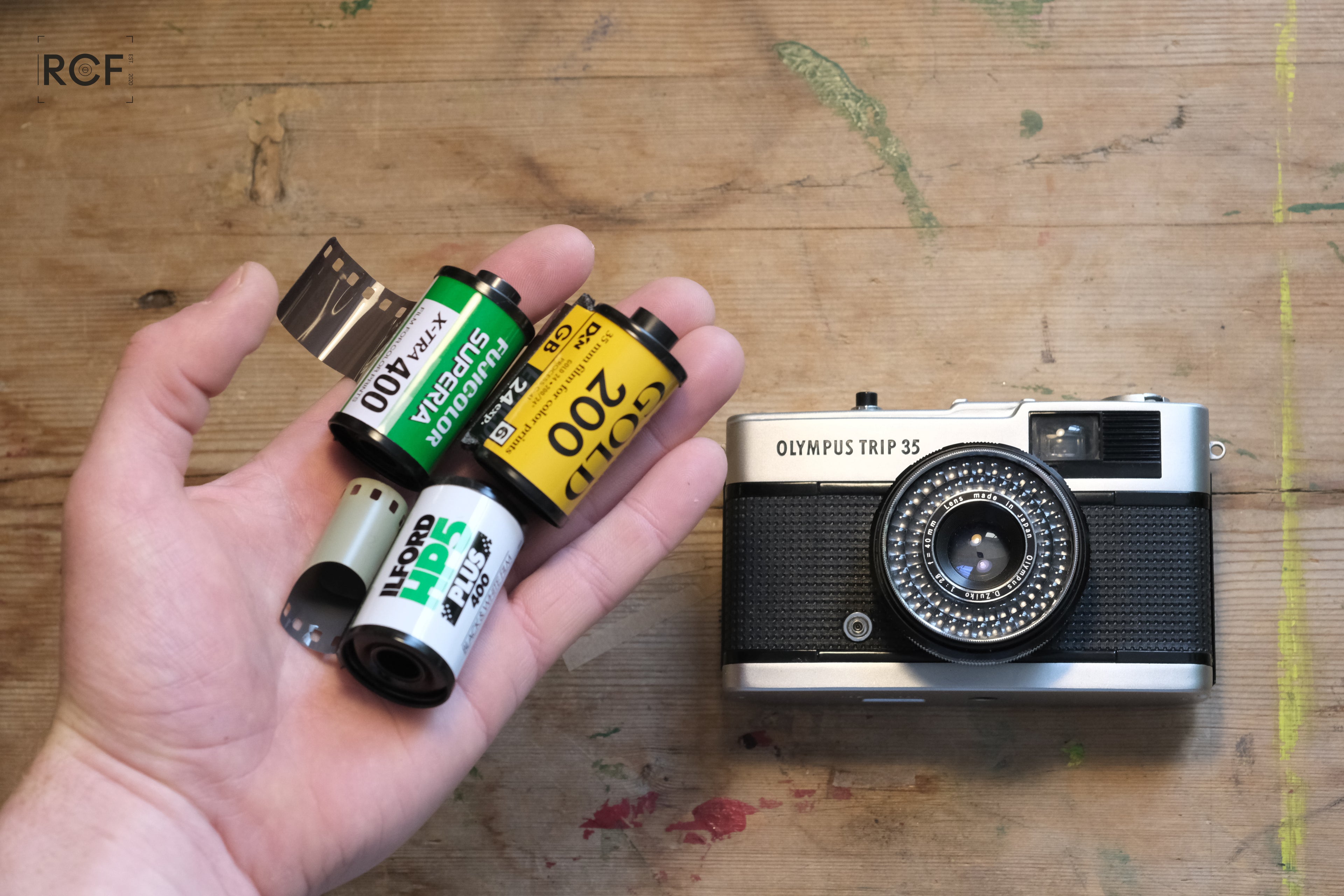
If you're the proud new owner of a vintage Olympus Trip 35 film camera, you're in for a treat! This classic piece of photographic history is perfect for capturing memories with a unique analog touch with ease. In this guide, I'll walk you through the step-by-step process of using your Olympus Trip 35, complete with images and important precautions to ensure you get it right every time.
Expand the relevant guide:
Collapsible content
Loading film into the olympus trip 35:.
Step 1: Choose your film
Select your preferred 35mm film roll, keeping in mind that the Olympus Trip 35 is compatible with ASA/ISO speeds ranging from 25 to 400.

Popular film brands include Kodak, Fujifilm, and Ilford. This post I wrote might be useful: Buying 35mm Film - A Complete Guide
Step 2: Set the film speed and set the camera to manual for film loading
Set the appropriate ASA/ISO speed for your film using the dial located on the front of the camera, near the lens.

Also turn the aperture ring to any manual f number against the red line so that it isn't set to 'A'. The shutter can now be released regardless of light conditions.
Step 3: Open the camera back
![olympus trip 35 serial number lookup [Image 2: The Olympus Trip 35's back lock tab]](https://cdn.shopify.com/s/files/1/0571/3212/2301/files/DSCF2797_480x480.jpg?v=1684491064)
Locate the back cover lock tab on the bottom of your Olympus Trip 35. Pull it down and the camera back should pop open.
Step 4: Insert the film cartridge
![olympus trip 35 serial number lookup [Image 3: Film cartridge being inserted into the camera]](https://cdn.shopify.com/s/files/1/0571/3212/2301/files/DSCF2798_480x480.jpg?v=1684491072)
Lift up the rewind knob and insert the film cartridge into the film chamber on the left side of the camera, making sure the tip of the film is pointing toward the take-up spool on the right side. Then push the rewind knob back down into the roll of film (sometimes needs a wiggle or slight rotation to go all the way back down).
Step 5: Engage the film leader into the take-up spool
![olympus trip 35 serial number lookup [Image 4: Film leader inserted into the take-up spool]](https://cdn.shopify.com/s/files/1/0571/3212/2301/files/DSCF2800_480x480.jpg?v=1684491080)
Pull the film across the camera and insert the tip securely through and into a slot on the take-up spool. Advance the film using the wind-on wheel.
Step 6: Align the film perforations
Ensure that the film perforations are aligned with the sprocket teeth on both sides of the film.
![olympus trip 35 serial number lookup [Image 4: Film leader inserted into the take-up spool]](https://cdn.shopify.com/s/files/1/0571/3212/2301/files/DSCF2801_480x480.jpg?v=1684491091)
This ensures the film will advance smoothly when winding.
Step 7: Close the camera back
Close the camera back tightly. The camera back should click shut, indicating it is securely closed.
![olympus trip 35 serial number lookup [Image 6: Closing the camera back]](https://cdn.shopify.com/s/files/1/0571/3212/2301/files/DSCF2803_480x480.jpg?v=1684491101)
IMPORTANT: Never open the camera back before fully rewinding the film, as this can expose your film to light and ruin your photos. Make sure to rewind the film completely after taking all 24 or 36 frames before unloading it.
Step 8: Advance film to '1'
Keep winding film and releasing the shutter until the film counter points to "1". This ensures the unexposed part of the film is ready for your first photo.

IMPORTANT: Watch the rewind knob when you wind the camera on ; it should start to rotate at the same time as you wind, indicating that the film has been taken up correctly - this is key, if this is not happening after a few shots then it probably means that the film has not been securely engaged by the take-up spool and the loading process will need to be repeated.

Step 9: Set the camera back to "Automatic" and get ready to shoot!
Turn the aperture ring until the 'A' mark is aligned with the red line in front of the viewfinder (click stop).

Your Olympus Trip 35 is now loaded with film and ready to capture amazing photos.

Taking Photos with the Olympus Trip 35:
How to take photos with the olympus trip 35:.
Step 1: Ensure the camera is wound on
This gets the shutter ready and primed to take a photo.
Step 2: Set subject zone focus distance on the lens
The Olympus Trip 35 has 4 settings which equate to focusing zone distances away from the camera (shown on the underside of the lens barrel):

- 🧍♀️Close focus ≈ 1 meter. This setting is used for focusing on anything ~1 meter away from the camera, be it close headshots or other close up details.
- 👥 Portrait ≈ 1.5 meters. Used for focusing on anything ~1.5 meters away from the camera, for example portraits or capturing wider details in the photo.
- 👯 Group ≈ 3 meters. Focusing on anything ~3 meters away from the camera, eg. full length body shots/group photos.
- 🌄 Scenery ≈ 5+ meters. Focusing on everything 5+ meters away from the camera, great for landscapes or subjects far away from the camera!
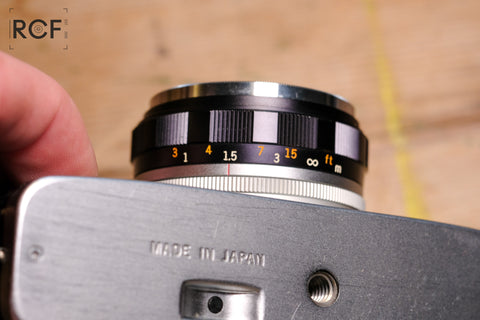
Step 3: Ensure aperture ring is set to 'A'
For 99% of situations in good light without a flash, it's best to leave the camera set to the red 'A'.

This lets the camera's solar powered meter set the exposure settings automatically and ensures a good exposure.
Step 4: Compose the photo using the viewfinder

Use the projected frame lines to see the area that will be captured in your photograph. There are hash marks to indicate the change in frame at close focus.
Step 5: Take photo by pressing shutter button

There should be a small click as the shutter fires - indicating a photo has been taken! 🙌 If instead a red flag appears in the viewfinder, this is a warning that there is not enough light in the scene for a proper exposure.

You can manually disable the red flag low light warning and take a photo anyway in low light by setting the aperture to '2.8'.
Towards the end of the roll it is important to not try to wind on the camera hard when you start feeling quite a lot of resistance or cannot wind on further - this signifies that the roll is finished, but if pushed too hard at this stage can result in the film snapping in the back of the camera.
Unloading Film from the Olympus Trip 35:
Step 1: Check the film counter
Once you've taken all the photos on your film roll (either 24 or 36 frames), check the film counter to ensure you've reached the end.
![olympus trip 35 serial number lookup [Image 10: Film counter indicating the last frame]](https://cdn.shopify.com/s/files/1/0571/3212/2301/files/DSCF2809_480x480.jpg?v=1684491137)
Towards the end of the roll it is important to not try to wind on the camera hard when you start feeling quite a lot of resistance - this signifies that the roll is finished and if pushed too hard can sometimes result in the film snapping in the back of the camera.
Step 2: Press rewind button in

Find the small black button on the base of the camera and push it in to disengage the film from the winding mechanism and allow the film to wind back into the film canister inside the camera.
Step 3: Rewind the film
Press the rewind button located on the bottom of your Olympus Trip 35. Then, turn the rewind knob clockwise to rewind the film back into the cartridge. Keep rewinding until you feel the tension release, indicating that the film has been fully rewound.
Step 4: Open the camera back

Following the same steps as when loading the film, locate the camera back lock tab on the bottom of your Olympus Trip 35. Pull it outwards to open the camera back.
Step 5: Remove the film cartridge
![olympus trip 35 serial number lookup [Image 13: Film cartridge being removed from the camera]](https://cdn.shopify.com/s/files/1/0571/3212/2301/files/DSCF2813_480x480.jpg?v=1684491173)
Pull up the rewind lever and lift the film cartridge out of the film chamber.
Step 6: Store and develop your film
![olympus trip 35 serial number lookup [Image 14: Film cartridge ready for storage or development]](https://cdn.shopify.com/s/files/1/0571/3212/2301/files/DSCF2814_480x480.jpg?v=1684491181)
Place the film cartridge in a light-tight container to protect it from light exposure. Take or send your film to a lab for development or develop it yourself using the appropriate chemicals and techniques.
Shop The Olympus Trip 35
Olympus trip 35 vintage 35mm film camera | tested & fully refurbished | 100 day guarantee, olympus trip 35 vintage 35mm film camera - forest slate green | tested & fully refurbished | 100 day guarantee, olympus trip 35 vintage 35mm film camera - burnt orange | tested & fully refurbished | 100 day guarantee, olympus trip 35 vintage 35mm film camera - golden yellow | tested & fully refurbished | 100 day guarantee, olympus trip 35 vintage 35mm film camera - teal green | tested & fully refurbished | 100 day guarantee, olympus trip 35 vintage 35mm film camera - royal blue | tested & fully refurbished | 100 day guarantee, olympus trip 35 vintage 35mm film camera - lipstick pink | tested & fully refurbished | 100 day guarantee, olympus trip 35 vintage 35mm film camera - sand beige | tested & fully refurbished | 100 day guarantee.
- Choosing a selection results in a full page refresh.
- Opens in a new window.
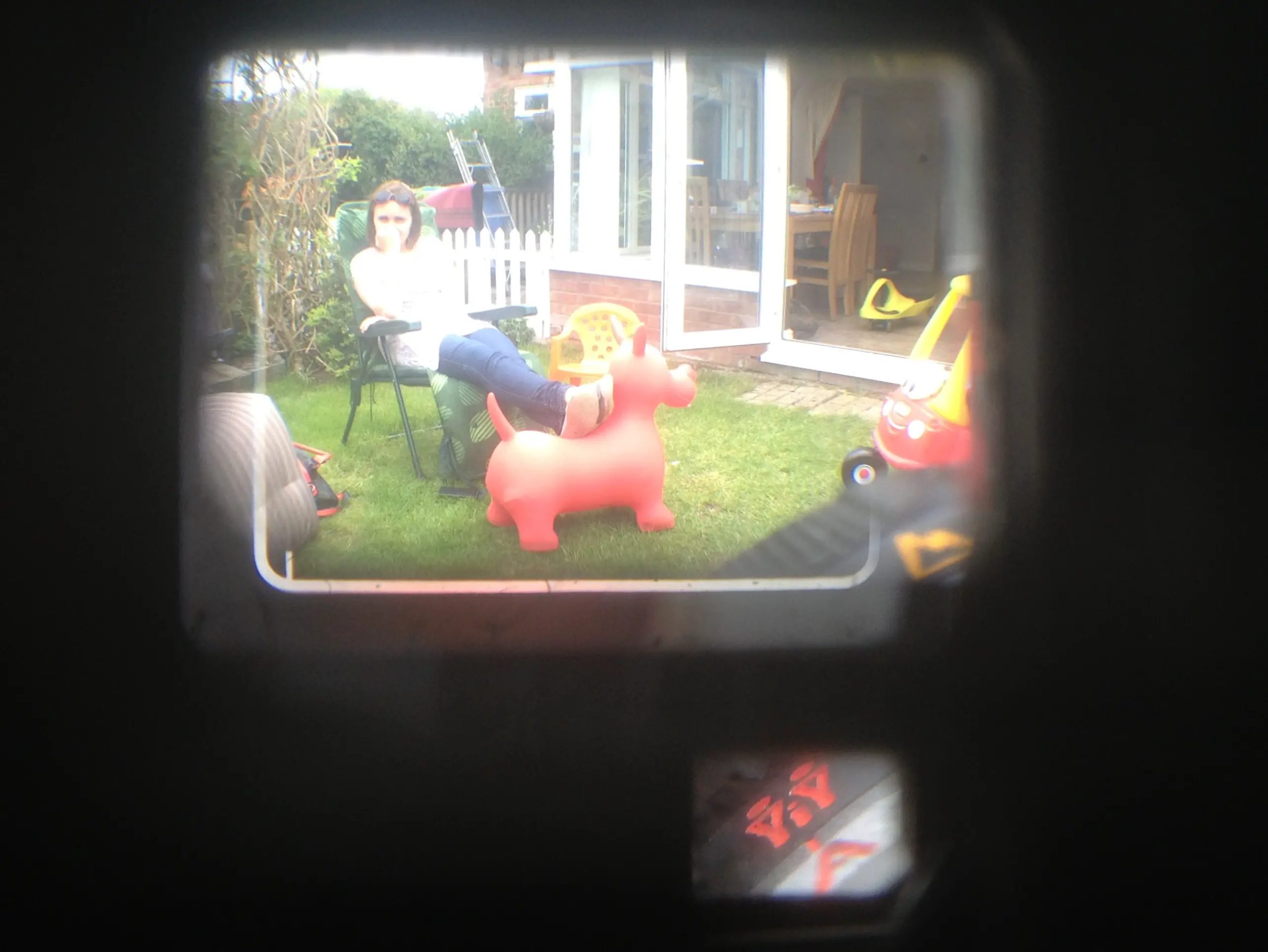
Olympus Trip 35 – Through the Viewfinder
22 May, 2013
Post Categories:
Share this post:
I’m going to take photos through the viewfinder of some cameras as I take a photo with the camera … I’m not mad, there have just been a few occasions where I would have liked to have known what to expect through a viewfinder before I bought the camera it was a part of… Ok maybe I am mad?
There is a small issue with this plan, the iphone is the only camera I can find that allows me to do it, because of this the quality seems a little dubious.
The first camera is the Olympus trip 35 a basic, but ultimately entirely functional viewfinder..
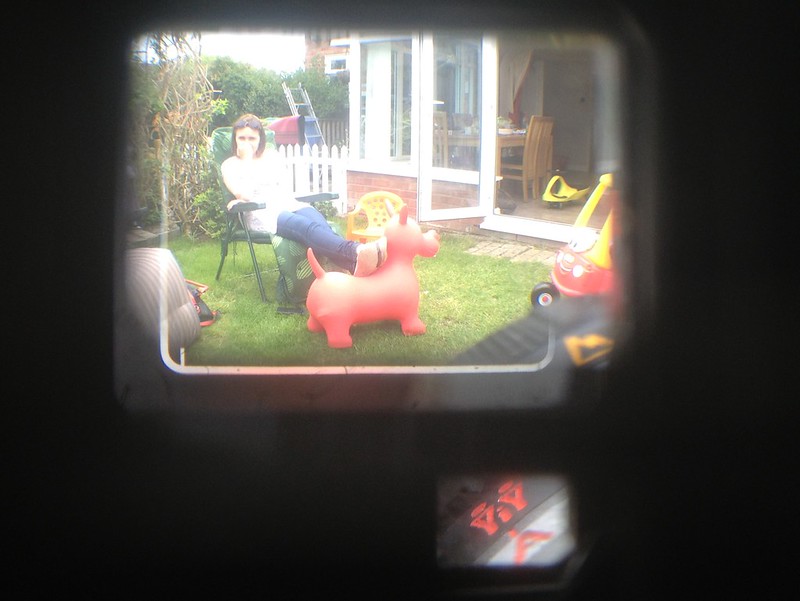
As you can see the frame lines (at least the ones visible in the shot) are pretty good. Perhaps a little off to the left of the frame, but not bad! You also have a nice view of the setting you have the camera set to. As you can see I had it on ‘A’ and the focus set to the picture of the 3 little people. In good daylight you can snap away with these settings without worry.
The viewfinder is plenty bright enough, and clear enough, despite (in my cameras case) being 44 years old.
You can read more of my thoughts on this wonderful camera here A cult classic point and shoot – Olympus Trip 35
Find more similar content on 35mmc
Use the tags below to search for more posts on related topics:
Contribute to 35mmc for an ad-free experience.
There are two ways to contribute to 35mmc and experience it without the adverts:
Paid Subscription – £2.99 per month and you’ll never see an advert again! (Free 3-day trial).
Subscribe here.
Content contributor – become a part of the world’s biggest film and alternative photography community blog. All our Contributors have an ad-free experience for life.
Sign up here.
About The Author
Trip 35 and some very cheap film and Connie. on Olympus Trip 35 – Through the Viewfinder
Comment posted: 23/05/2013
Leave a Reply Cancel reply
Your email address will not be published. Required fields are marked *
Save my name, email, and website in this browser for the next time I comment.
Notify me of new posts by email.
John on Olympus Trip 35 – Through the Viewfinder
Comment posted: 02/11/2018
Leave a Comment
Related Posts
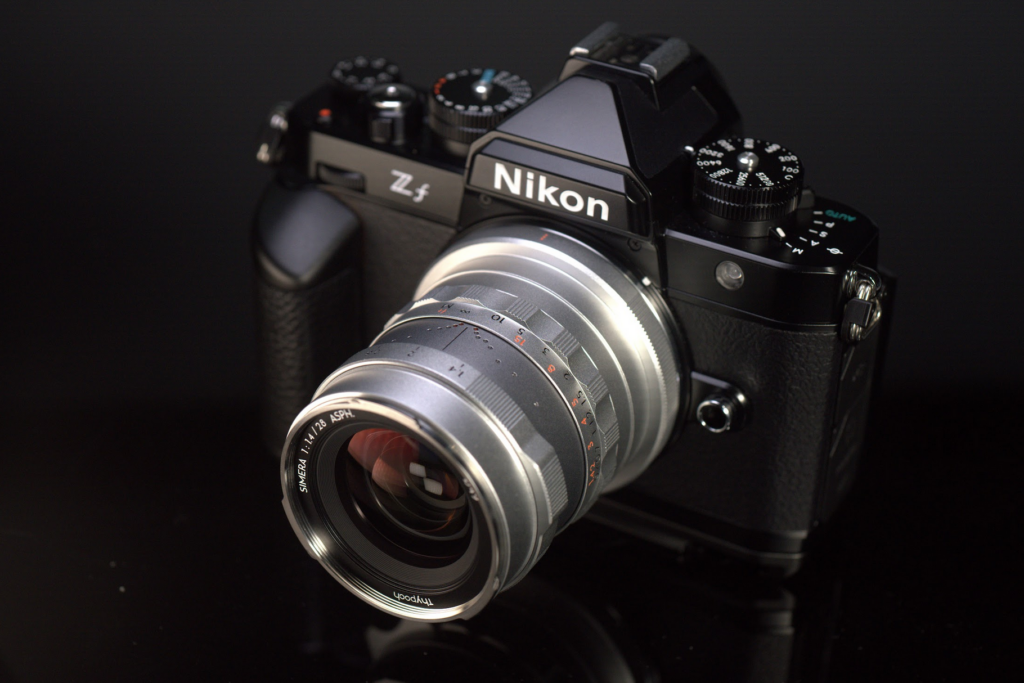
17 May, 2024
By Molly Kate

15 May, 2024
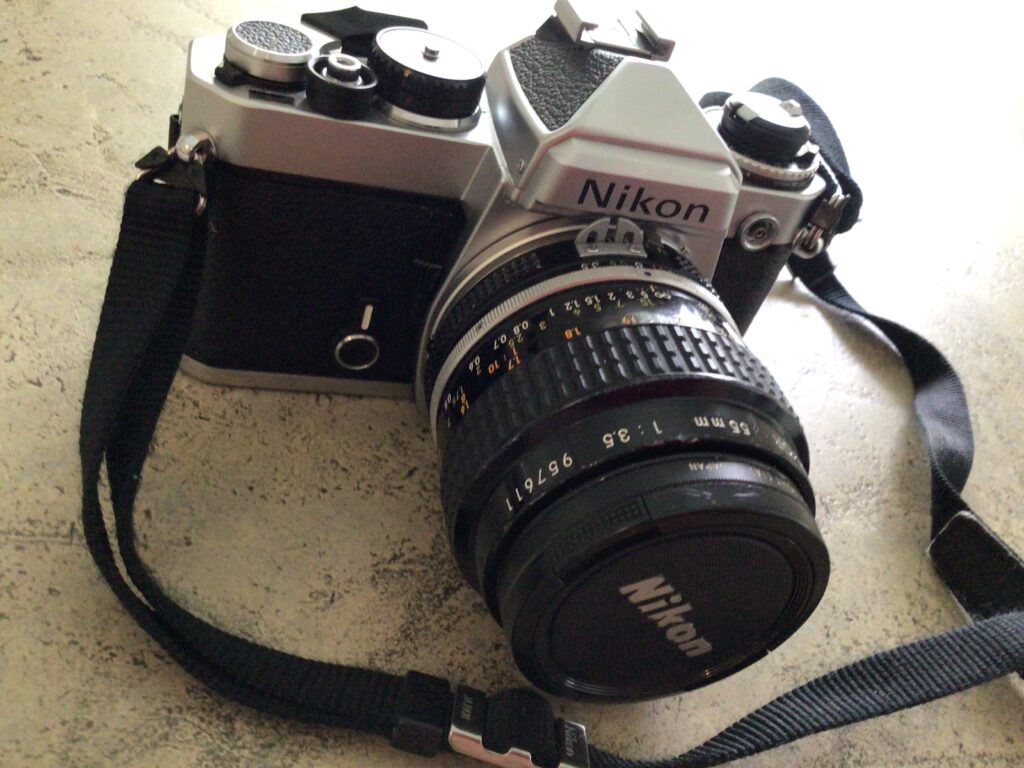
By Ron Duda

13 April, 2024

Photography & Projects
Looking for some inspiration, or just want to flick through the project work and photos?

Reviews & Experiences
If you're looking for photography equipment and peripheral reviews, this is the place to start!

Theory & Reflections

Tutorials & Knowhow
If you want to learn or discover a new technique, build on your skills, or be inspired to have a go at a bit of DIY or camera modification, then you’re in the right place.
Contribute to 35mmc
Paid Subscription
£2.99 per month and you’ll never see an advert again! (Free 3-day trial).
Subscribe here
Content contributor
Become a part of the world’s biggest film and alternative photography community blog. All our Contributors have an ad-free experience for life.


IMAGES
VIDEO
COMMENTS
The serial number on an Olympus Trip 35 camera does *not* give you a precise date of manufacture. The only way to tell is to open the film compartment and carefully remove the pressure plate on the back of the door (this is quite easy. It simply slides free from its locating pins) and look for a code on the back of the pressure plate.
john millar: The serial number on an Olympus Trip 35 camera does *not* give you a precise date of manufacture. The only way to tell is to open the film compartment and carefully remove the pressure plate on the back of the door (this is quite easy. It simply slides free from its locating pins) and look for a code on the back of the pressure plate. The code consists of 3 characters: 1st ...
The Olympus Trip 35 is a fully-automatic 35mm compact camera, manufactured by Olympus from 1967 to 1984, during which time over ten million units were sold, though this oft-quoted figure is likely to have included later plastic-bodied Olympus cameras with Trip branding, as the original Trip 35 had serial numbers going up to around 5,400,000. The auto-exposure mechanism is effectively solar ...
Lots of questions about serial numbers for early chrome Trips and serial numbers for All Black Trips. I've serviced over 300 trips so far Early chrome pre 1970 I've had 18 pass through my hands The...
3rd number or letter represents month of assembly (1-9 for Jan-Sept, X,Y,Z for Oct-Dec); Thus the code N1Y = November 1971. Note that serial numbers for the original Olympus Trip 35 go up to about 5,400,000, which may mean that the figure of over ten million units sold over the production run may include later plastic-bodied Trip-branded cameras.
U 001493 [ultrasonic wave cleaner count, equals turn on count plus pixel map count] - [may have changed count usage with E-M1 Mk2] V 000000 [unknown] B 002396 [total shot count using in-body stabilisation (IBIS)] L 000000 [unknown] On Page 4 is D: which is the damage code log, mine shows nothing and that is good.
This is an Olympus Trip 35, a 35mm scale focus camera made by Olympus Optical Co., Ltd. between the years 1967 and 1984. ... but based on serial number research, the actual number is probably closer to half that. But even with 5 million units sold, the Olympus Trip 35 remains one of the most successful single models of any camera ever made ...
3rd number or letter representing the month of assembly, 1-9 for Jan-Sep, X, Y, Z for Oct-Dec. for example; N1Y = November 1971 Of course the TRIP 35 was manufactured between 1967 and 1984, so if you are unsure if you have a 1968 or 1978 model, the chrome shutter button is the earlier and the black the later.
Feb 21, 2016. #4. I've read conflicting reports online about the production years for this camera. In one account, the camera was produced continuously from 69 to 76. In the other account, from 69 to 71-72 when it was replaced by the 35spn. I have three.
Looking at the actual serial numbers, it is more likely that Olympus built around 5.4 million units of the Trip 35. Paul is also known as Trip Man (https://www.tripman.co.uk), selling refurbished classic Trip 35 cameras and accessories online out of England. He is a true authority and thus my perfect guide to this wonderful little camera.
The Trip 35 is a fully-automatic 35mm compact camera, manufactured by Olympus from 1967[1] to 1984, during which time over ten million units were sold.[1] (This oft-quoted figure is likely to have included later plastic-bodied Olympus cameras with Trip branding, as the original Trip 35 had serial numbers going up to around 5,400,000.)[2] The auto-exposure mechanism is effectively solar-powered ...
The top cover of the Olympus Trip 35 houses the hot shoe, shutter release, serial number and frame counter. Behind the shutter release, on the back of the top cover assembly, is the thumbwheel film advance. (Daniel J. Schneider) The light meter uses a selenium photovoltaic cell, with a large light-gathering matrix surrounding the lens.
124×72×57 mm (4.9×2.8×2.2 in) Weight. 390 g (390 g) Made in. Japan. The Olympus Trip 35 is a 35mm compact camera, manufactured by Olympus. It was introduced in 1967 and discontinued, after a lengthy production run, in 1984. The Trip name is a reference to its intended market—people who wanted a compact, functional camera for holidays.
Olympus Trip 35. Olympus Trip 35. These were extremely popular, simple cameras made between 1967 and 1984. My particular specimen was made in April 1982. In 1970, Wallace Heaton (a photographic retailer in London) was offering this camera for £34-14-. The camera is small - 215mm by 170mm by 160mm - and is quite light by film camera standards.
Meet my new baby. Serial number and date of production: 2775867/ March 1971. The Trip 35 is a fully-automatic 35mm compact camera, manufactured by Olympus from 1967 to 1984, during which time over ten million units were sold.(This oft-quoted figure is likely to have included later plastic-bodied Olympus cameras with Trip branding, as the original Trip 35 had serial numbers going up to around ...
The following specifications of the Olympus Trip 35 are as stated in the manual, whilst the rest obtained by dismantling the camera. Made in. Japan; Serial Number. 3641141; Film Size. 24 mm × 36 mm; Lens System. D. Zuiko; F2.8; Focal length 40 mm; Four elements in three groups; Shutter Mechanism.
The sticker on the camera came off and I need to know the serial number to process a guarantee, does anyone know a method? I just checked LRC 12.2 & it showed s/n of my OM 1, M1 III & M1 II on my last trip. I went back to a trip in 2005 & it showed my E1 & trip in 2008 showed my D3. LRC also showed software version on all 5 cameras.
The Olympus Trip 35 is so popular because it's very easy to use, it has a great lens and it's ideal for the novice photographer. Also, the Olympus Trip 35 is one of the only 35mm cameras powered by the sun, making it really handy to take on holiday with you. Since 1967 10 million units have been sold, which is a tremendous amount even today.
The Olympus Trip 35 is a cracking little camera that is capable of some stunning results from its 40 mm f/2.8 Zuiko lens. Here is a short guide for getting the best results from this camera. Image from George Rex from Wikimedia Commons. The lens of the Olympus Trip 35 is as sharp as a pin. As good as this camera is it does have its limitation.
The Olympus Trip is really easy to use, and has some cool features that set it apart from other point and shoot 35mm film cameras. Zuiko coated 40mm f/2.8 lens: this lens is sharp, and the wide aperture makes it versatile in a lot of situations. Automatic settings: the Olympus Trip has two shutter speeds and aperture from f/2.8 to f/22.
Dig a little deeper however, and you find that based on serial numbers and production dates, it is more likely that they in fact produced approximately 5.6 million units, with a grand total of 10 million if you count all other Olympus cameras that carry the "Trip" branding in whatever shape or form.
How to Take Photos with the Olympus Trip 35: Step 1: Ensure the camera is wound on. This gets the shutter ready and primed to take a photo. Step 2: Set subject zone focus distance on the lens. The Olympus Trip 35 has 4 settings which equate to focusing zone distances away from the camera (shown on the underside of the lens barrel):
The first camera is the Olympus trip 35 a basic, but ultimately entirely functional viewfinder.. So, here is the view through the finder. And the shot I took. As you can see the frame lines (at least the ones visible in the shot) are pretty good. Perhaps a little off to the left of the frame, but not bad!